Teal kitchens have surged in popularity as homeowners and designers seek vibrant yet versatile hues that balance depth and freshness. This rich, green-blue shade can transform cabinetry, islands, backsplashes, and accents into focal points, complementing a wide range of materials—from warm woods to cool marbles. Whether rendered in glossy or matte finishes, paired with brass hardware or contrasted against crisp whites, teal infuses kitchens with personality and sophistication. Real-world renovations demonstrate its impact: a recent San Antonio remodel featured teal lower cabinets offset by white uppers and marble countertops, creating a bright, uplifting workspace. Designers praise teal’s ability to work with various styles—modern, coastal, bohemian, and vintage alike—making it a go-to choice for those craving color without compromising timeless appeal.
1. Bold Teal Cabinetry
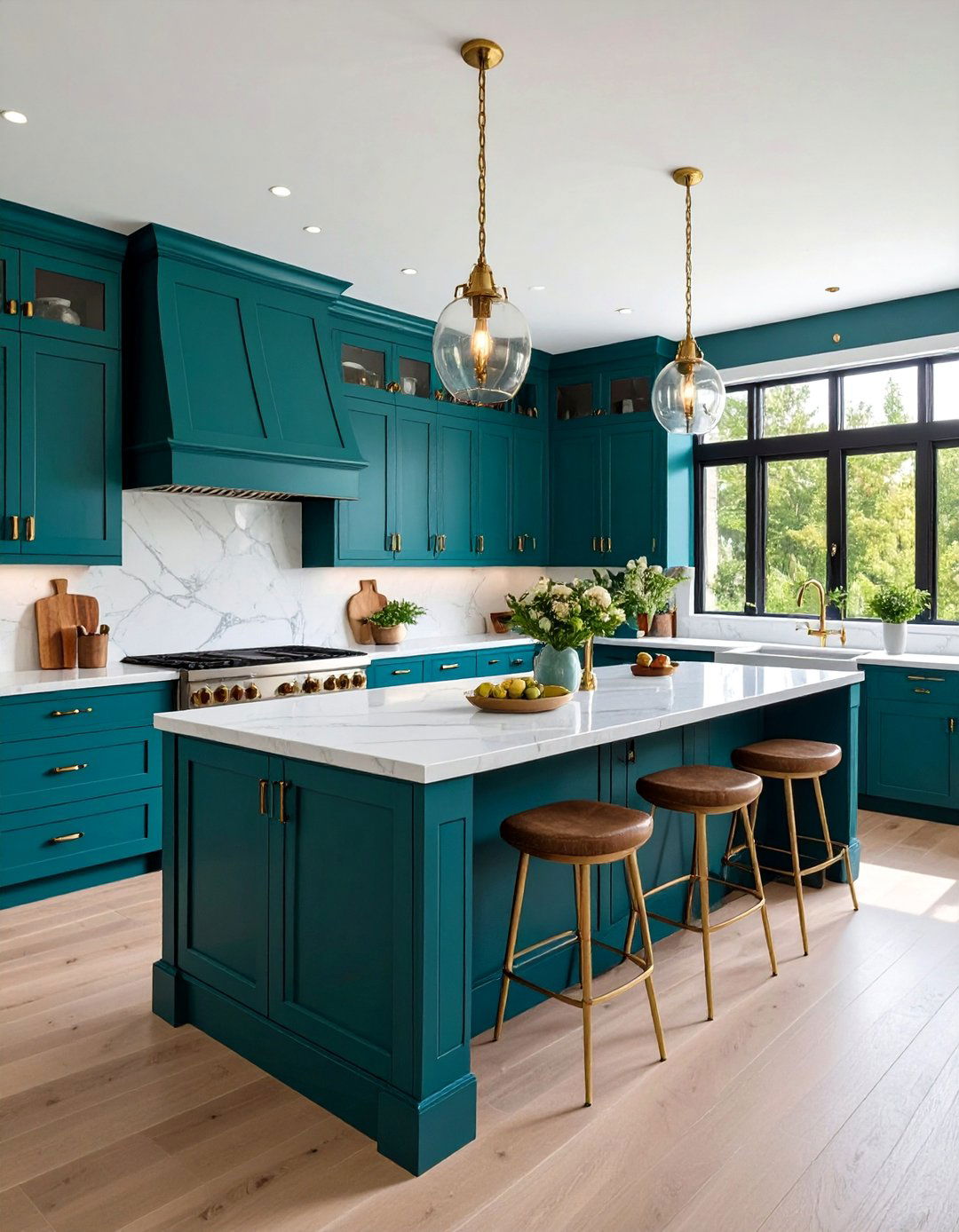
Painting entire cabinets teal creates an immersive, jewel-tone environment that commands attention. This approach works especially well in open-concept layouts, where the cabinetry becomes the room’s centerpiece. Deep, saturated teal on lower cabinets grounds the space, while lighter wall colors keep the overall look balanced and airy. Teal cabinetry pairs beautifully with brass or matte-black hardware, providing contrast and a touch of luxury. Incorporating under-cabinet lighting enhances the cabinet’s hue, making the color appear richer and more dynamic. Designers suggest anchoring bold cabinetry with neutral countertops—such as white quartz or soapstone—to prevent the palette from feeling too heavy.
2. Teal Backsplash Accents
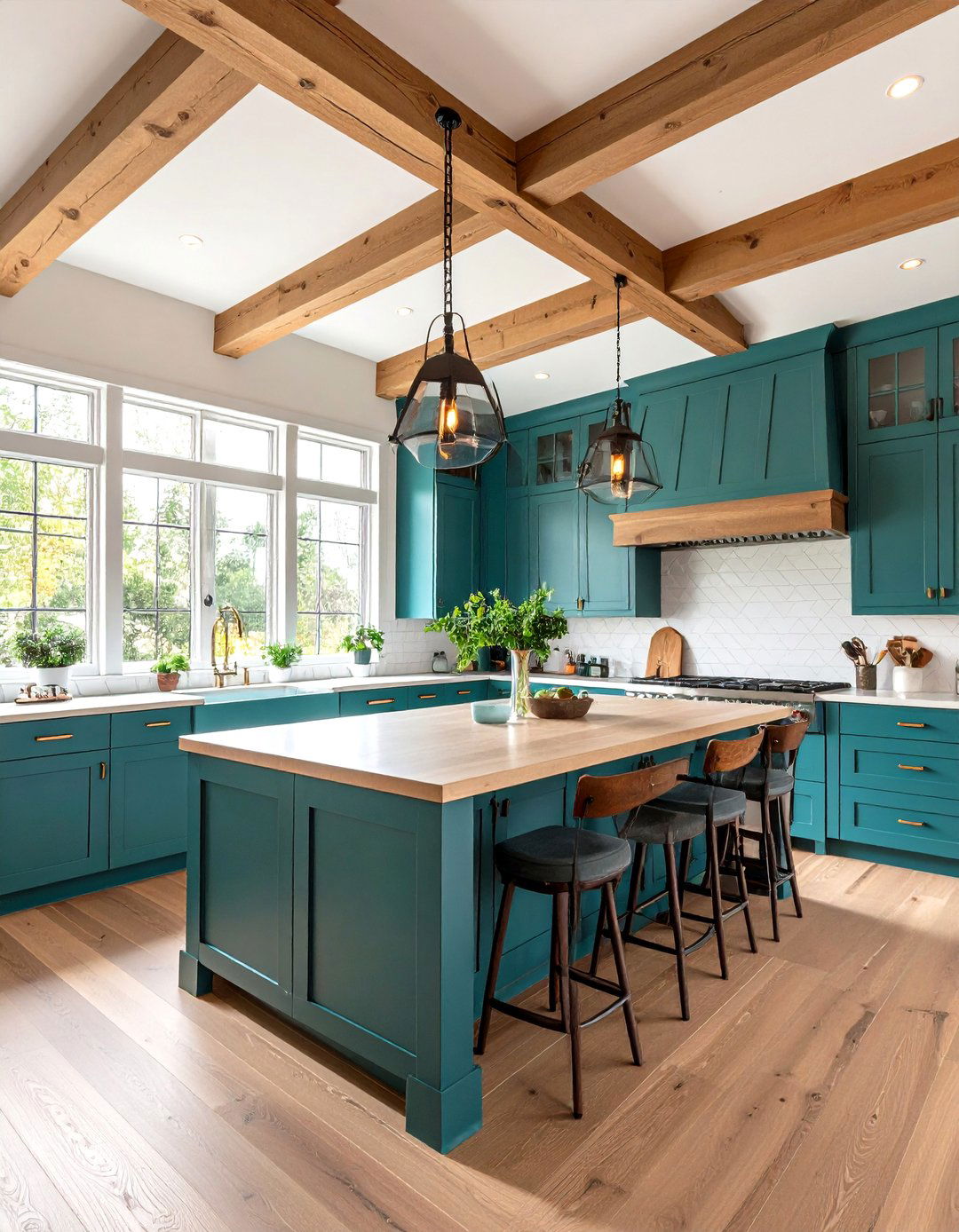
A teal backsplash offers a focused injection of color without overwhelming the kitchen. Subway tiles in varying shades of teal create depth and visual interest, while mosaic or geometric patterns add texture and personality. In smaller kitchens, a single run of teal tile behind the cooktop or sink serves as a striking accent against white or gray cabinets. Pairing teal backsplash tiles with warm wood open shelving softens the look, preventing it from feeling too cold. Grout color also influences the effect—white grout brightens the teal, whereas dark grout creates a more dramatic, graphic appearance.
3. Two-Tone Teal Schemes

Combining teal with a neutral or complementary hue on different cabinetry sections introduces sophistication and balance. Popular pairings include teal lower cabinets with white uppers, or teal islands contrasted against natural wood or gray perimeter cabinets. This division draws the eye to key features—often the island—while keeping the rest of the kitchen light and open. Two-tone schemes allow experimentation with texture: glossy teal island cabinets can contrast with matte neutrals elsewhere, adding dimensionality. This strategy also mitigates color fatigue, making bold teal more approachable in everyday living.
4. Teal Open Shelving
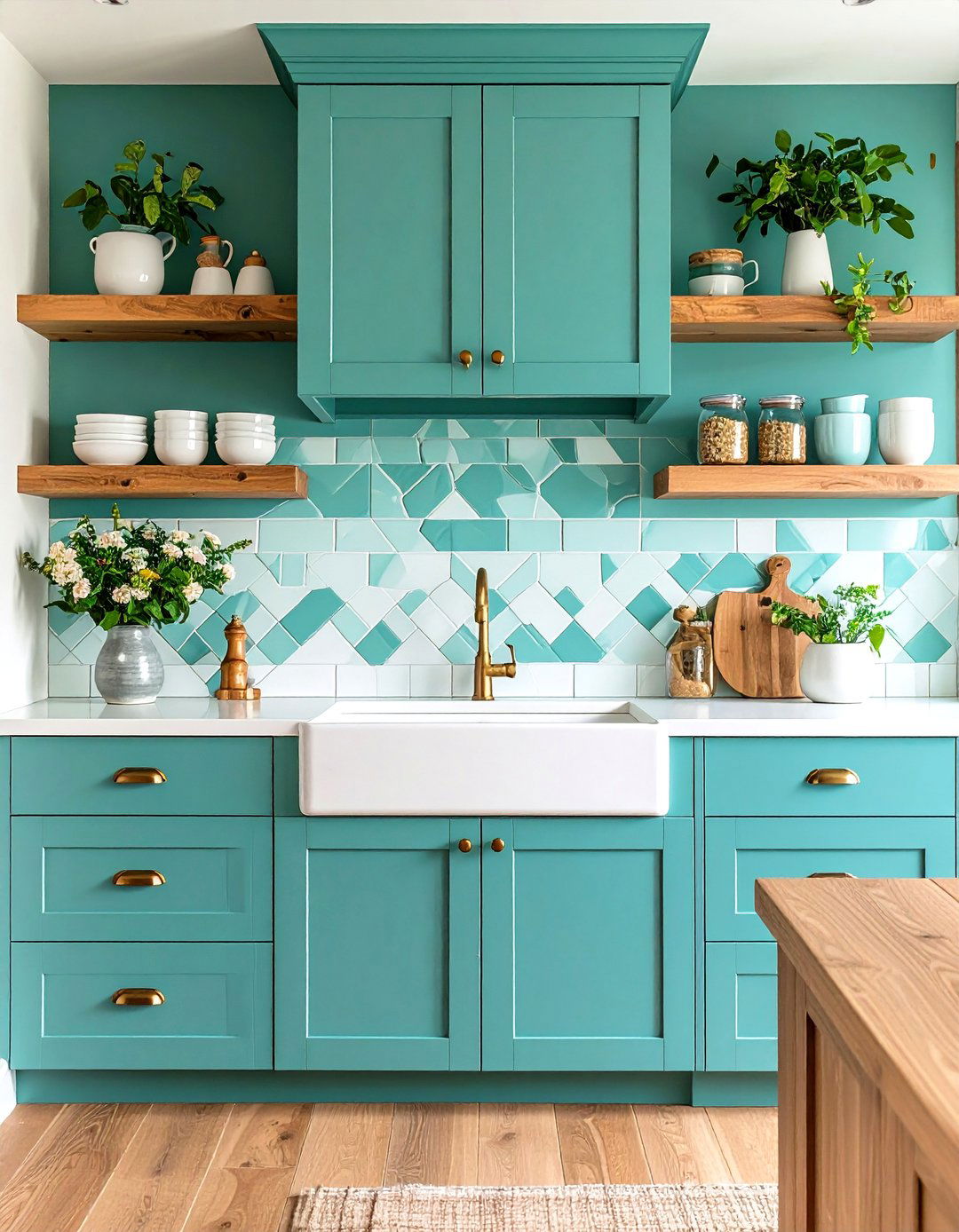
Open shelving painted in teal injects color into kitchens without the permanence of full cabinetry. Floating teal shelves display dishes and décor, becoming functional artwork against neutral walls. This look melds modern minimalism with vintage charm, especially when paired with reclaimed wood or rattan baskets. Teal open shelving works particularly well in eat-in kitchens or breakfast nooks, where it frames a focal point without cluttering the visual field. Accent these shelves with potted herbs or ceramics in complementary tones—mustard, terracotta, or blush—to enrich the palette.
5. Teal Island Statement
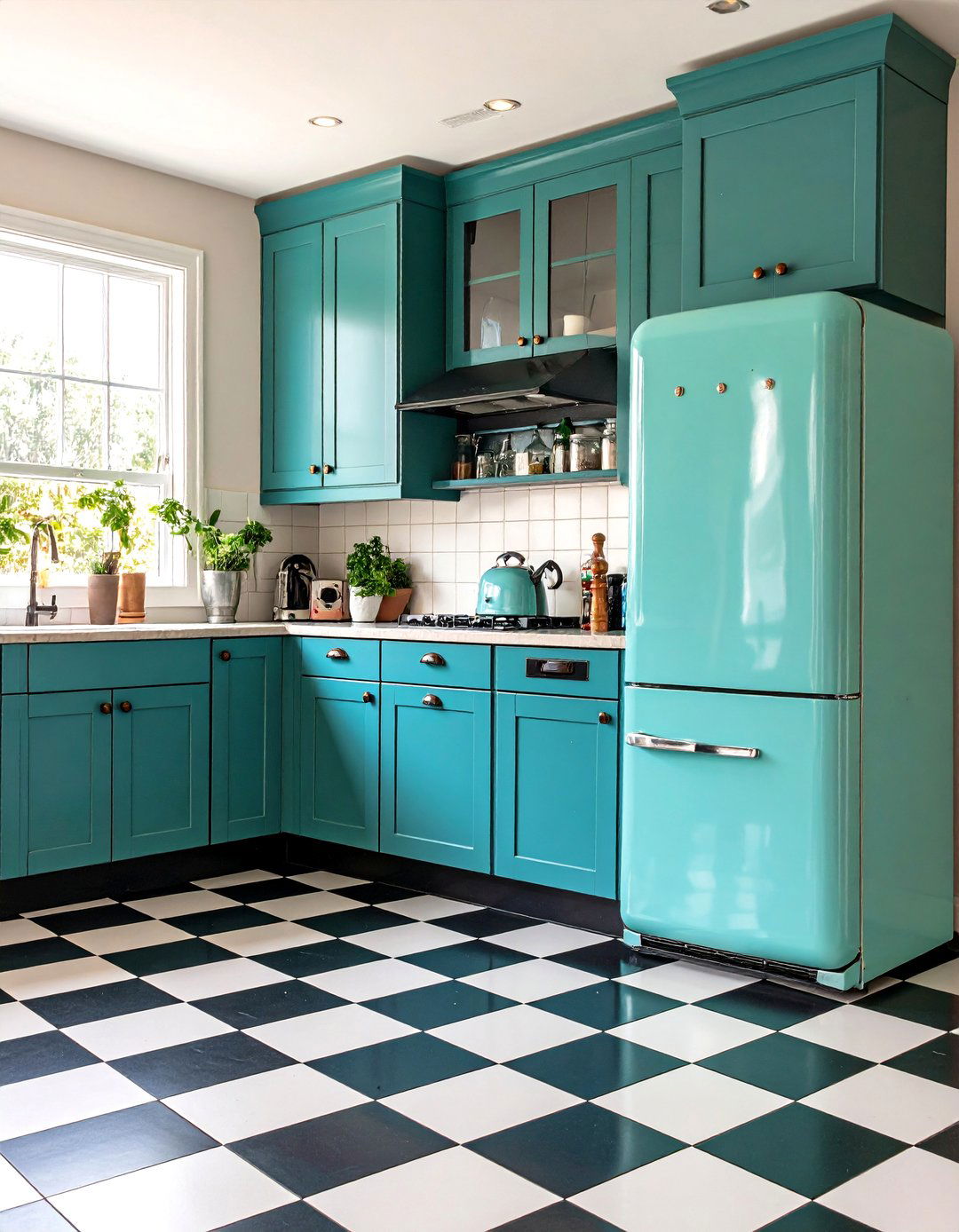
Transform the kitchen island into a show-stopping feature by painting it teal. Islands painted in this hue stand out in open plans and serve as gathering spots for cooking and socializing. To maximize impact, pair a teal island with a contrasting countertop—marble, butcher block, or concrete. Incorporate mixed-material elements, such as metal stools with teal cushions or teal pendant lights overhead, to tie the look together. In larger kitchens, extending the teal finish to an adjoining pantry door or bar area creates cohesion and flow.
6. Teal and Brass Hardware
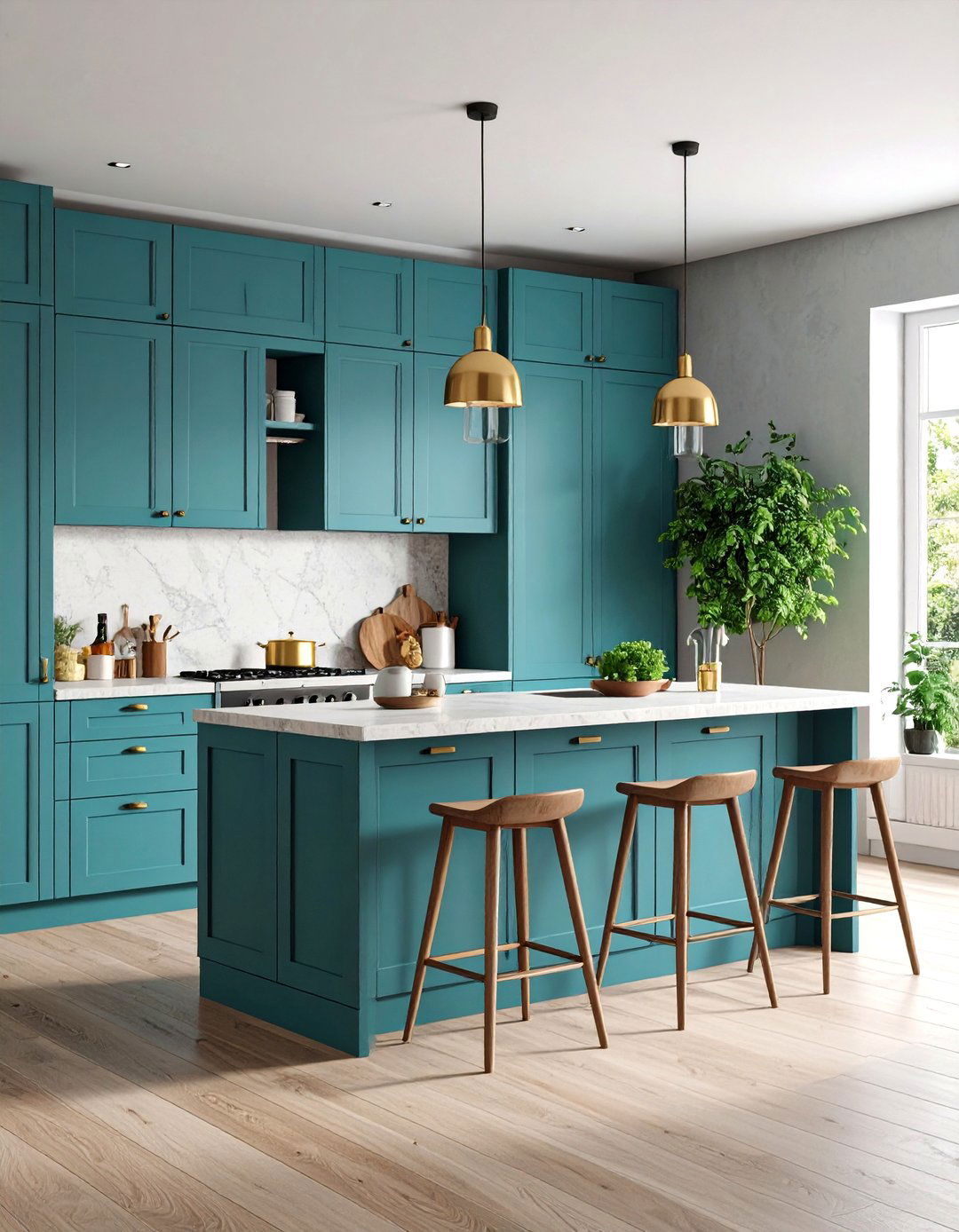
Brass hardware adds warmth and an upscale feel when paired with teal cabinetry or accents. Drawer pulls, knobs, and faucets in brushed or polished brass pop against the cool undertones of teal, creating a luxurious contrast. This combination feels both modern and nostalgic, reminiscent of mid-century design with a contemporary twist. For cohesion, integrate brass in lighting fixtures or accent décor—such as barware and utensil holders—to ensure the metallic warmth is distributed evenly throughout the space.
7. Teal Tile Flooring
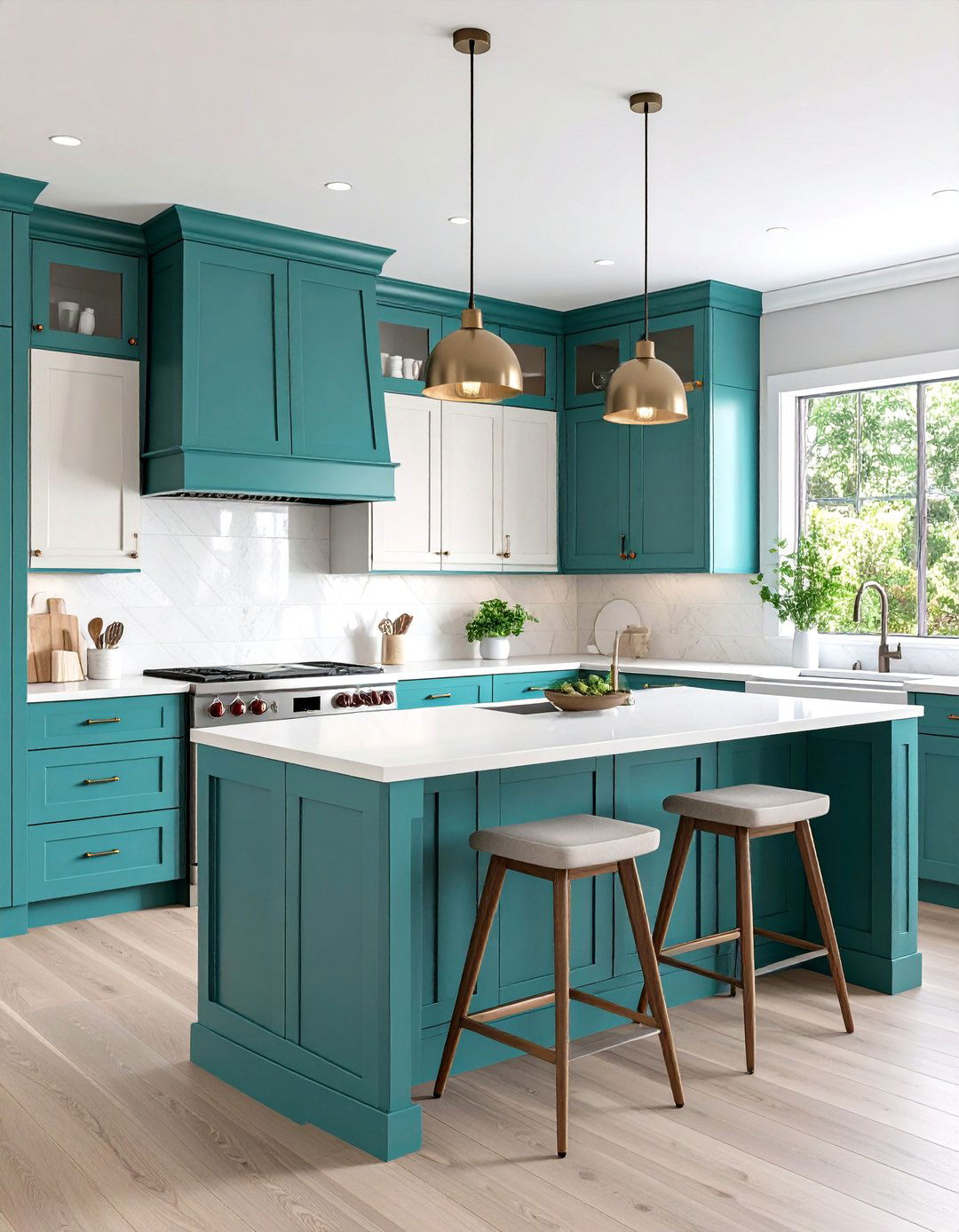
Extending teal into the flooring creates an unexpected, immersive experience. Patterned encaustic or cement tiles in teal and white can evoke Mediterranean or Moroccan influences, adding global flair. Alternatively, large-format teal porcelain tiles offer a sleek, modern canvas. To avoid overwhelming the space, limit adjacent cabinetry to neutrals and introduce natural textures—like jute rugs or wooden seating—to break up expanses of color. Teal floors also pair wonderfully with under-floor heating, ensuring that the vibrant tiles feel welcoming underfoot.
8. Teal and Wood Contrast
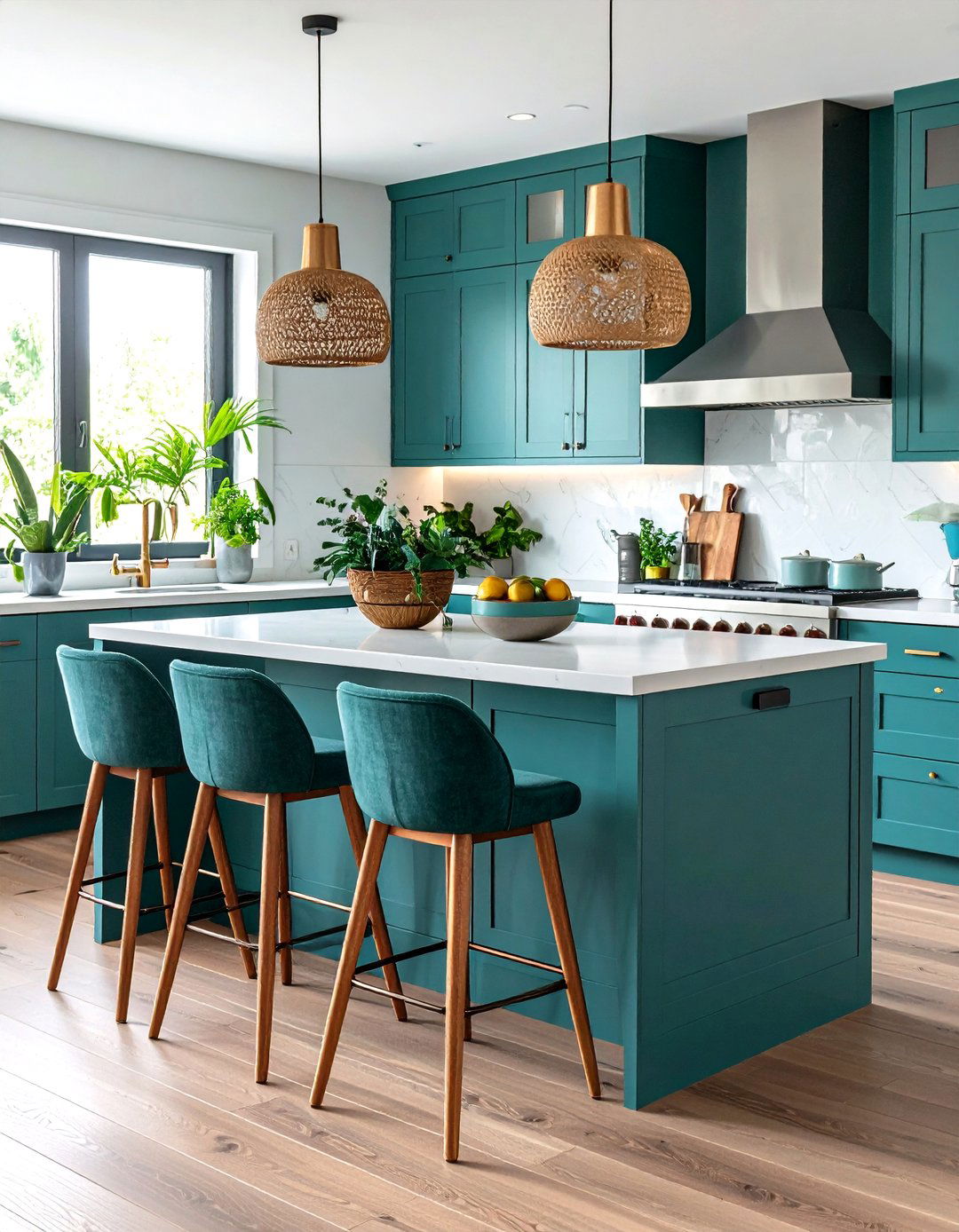
Teal’s cool richness balances beautifully against warm wood tones. Combining teal cabinetry or accents with butcher-block countertops, open shelving, or hardwood floors creates a harmonious interplay of warm and cool. This contrast enhances both materials, highlighting wood’s natural grain against the vibrant backdrop. For a cohesive approach, select wood finishes—walnut or oak—with undertones that complement teal’s depth. Wood ceiling beams or decorative trusses in the same tone further tie the scheme together, grounding the design in natural warmth.
9. Teal Open Concept
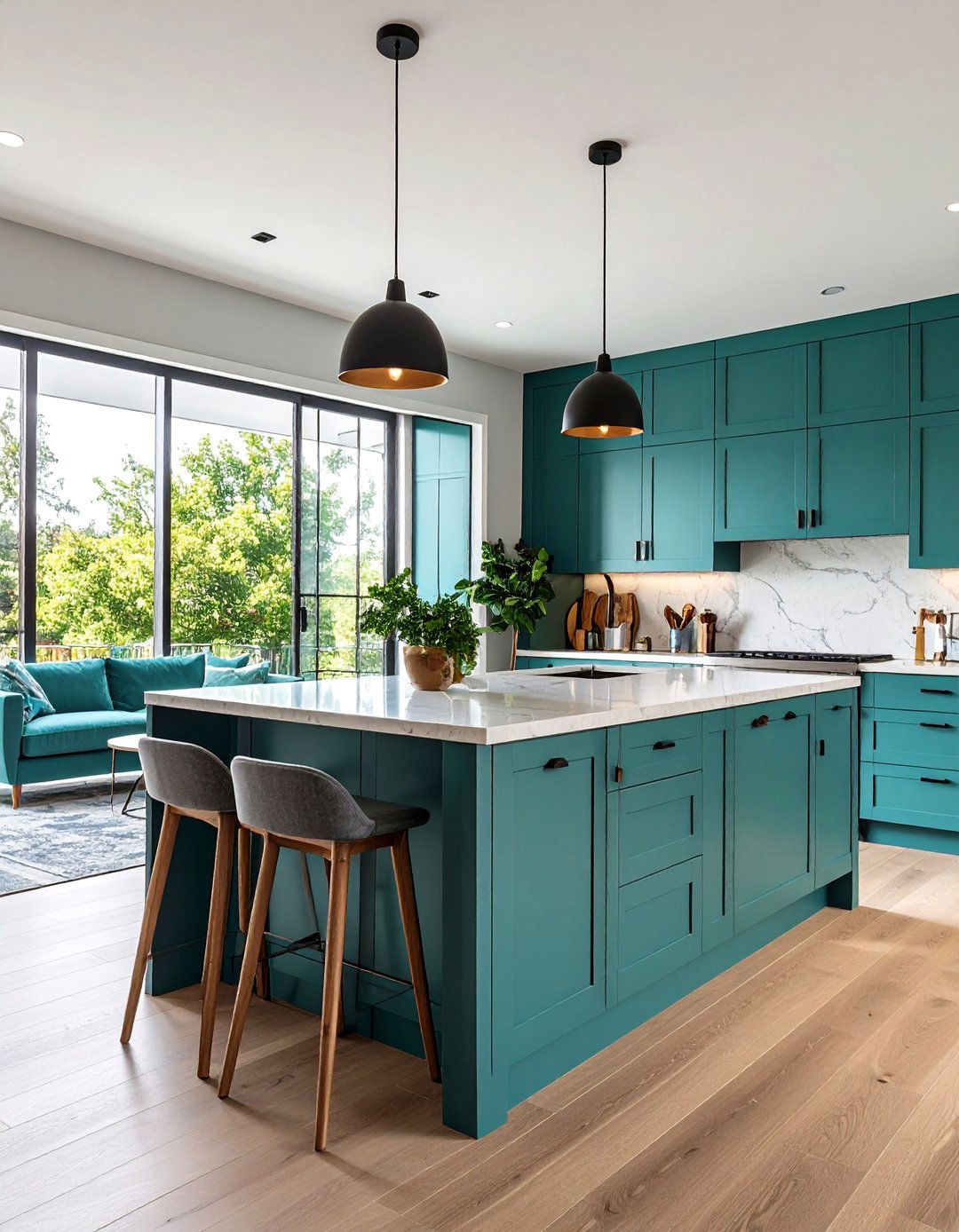
In open-plan homes, teal elements serve as visual anchors that define the kitchen zone. A teal island or accent wall delineates the cooking area from the living or dining spaces, providing a clear boundary without physical barriers. Carry teal through other decor—pillows, vases, or artwork—in adjacent rooms to maintain continuity. Strategically placed teal elements ensure the open concept feels cohesive rather than disjointed, enabling the color to flow organically throughout the living area and kitchen.
10. Teal Matte Finishes
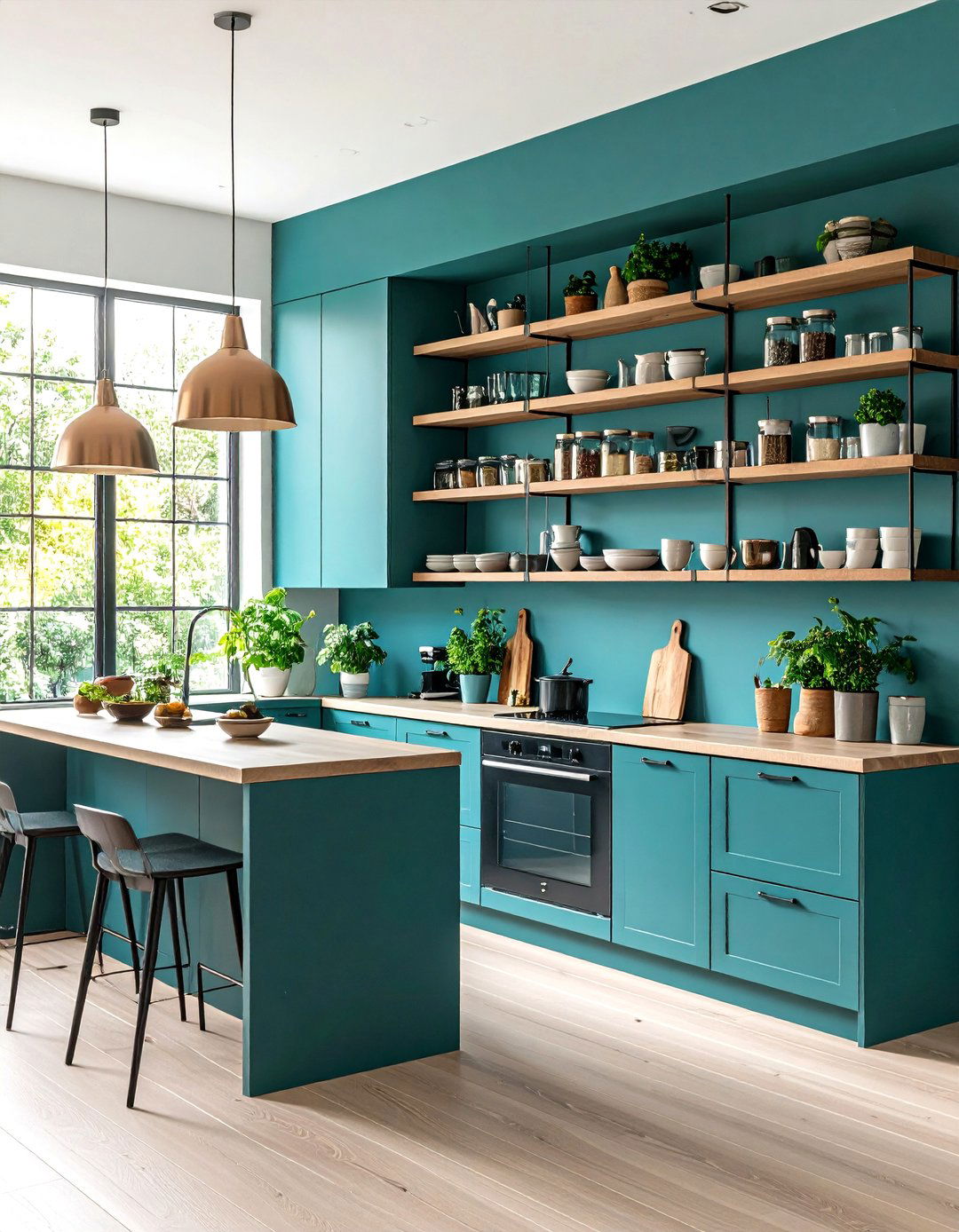
Matte teal cabinetry exudes understated sophistication and a modern sensibility. The flat, non-reflective surface highlights the color’s depth without flashy sheen, making it ideal for minimalist or Scandinavian-inspired kitchens. Matte finishes also conceal fingerprints and smudges better than glossy alternatives, reducing maintenance in high-traffic areas. Complement matte teal with textured wall treatments—plaster or shiplap—to enhance tactile interest and prevent the look from feeling too flat.
11. Teal Glossy Finishes
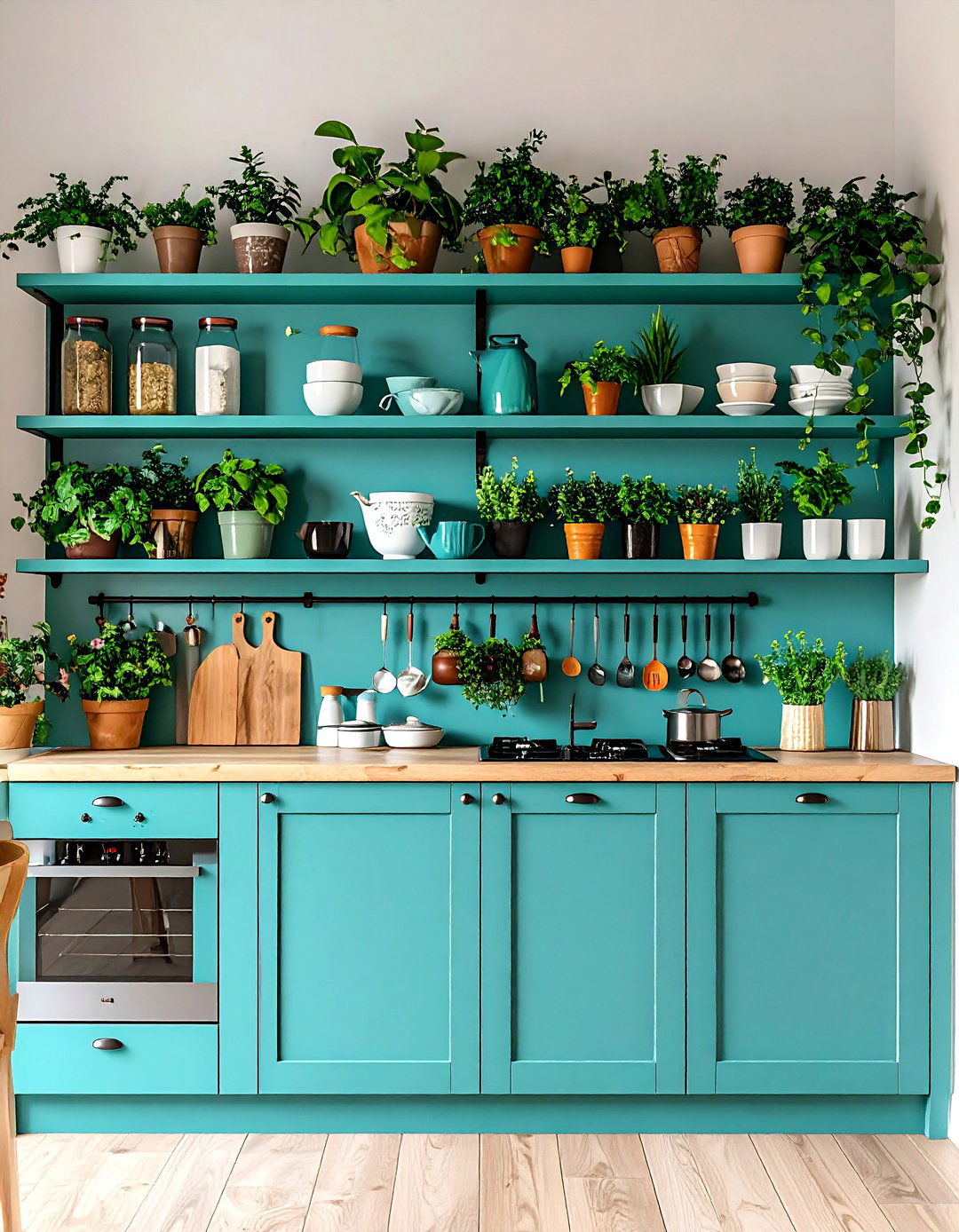
High-gloss teal cabinets reflect light and create an energetic, contemporary vibe. The reflective surface amplifies natural and artificial lighting, making smaller kitchens feel larger and more dynamic. Glossy finishes pair well with sleek hardware and modern appliances, reinforcing a streamlined aesthetic. To balance the shine, integrate matte or natural elements—such as stone countertops or woven bar stools—ensuring the gloss remains striking without overwhelming the space.
12. Teal and White Minimalism
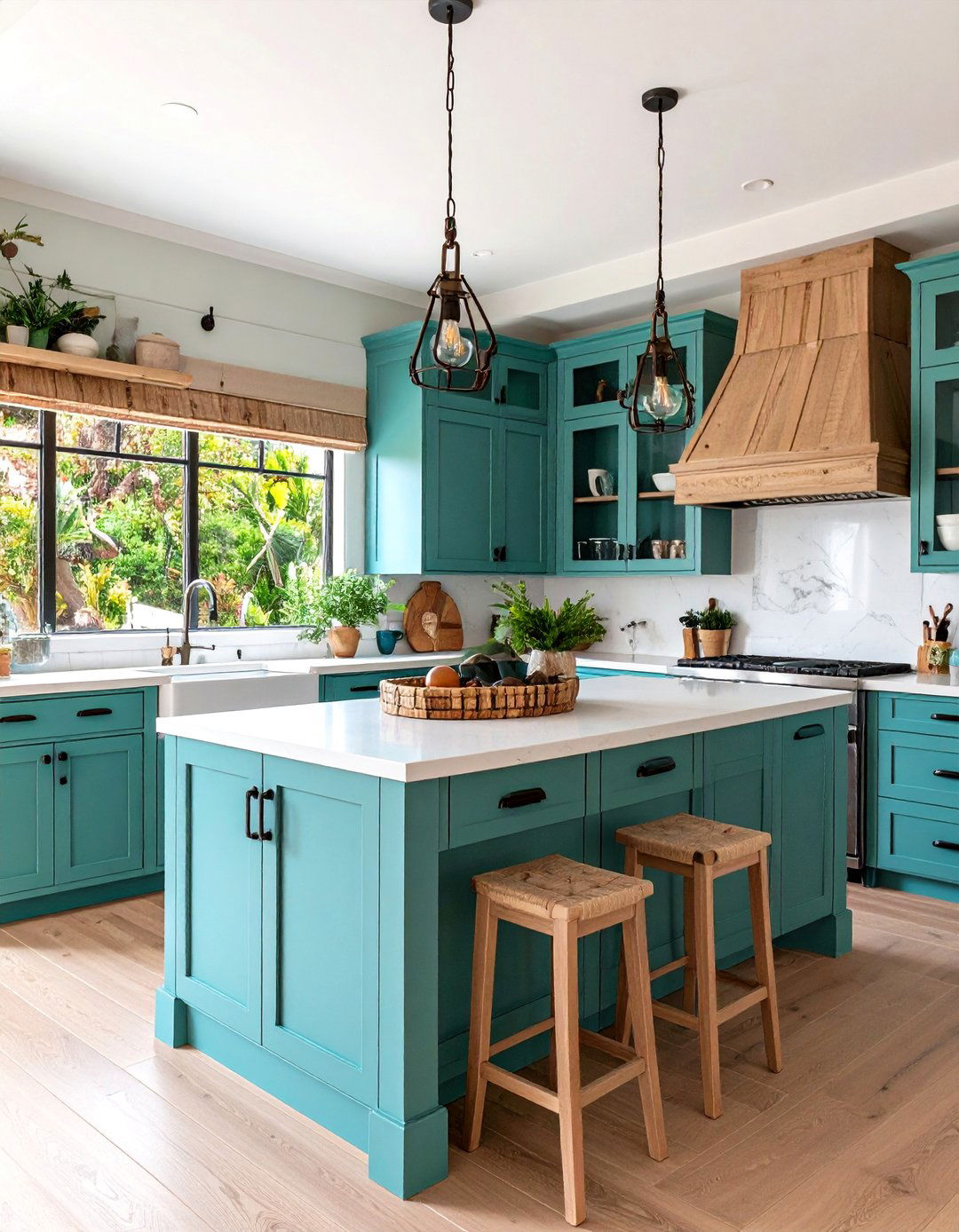
Pairing teal with crisp white achieves a fresh, minimalist kitchen that feels both bold and serene. White walls and countertops provide a clean backdrop for teal cabinetry or islands, allowing the color to stand out without clutter. This scheme benefits from ample natural light and simple, uncluttered styling. Accessories kept to a minimum—steel bar stools, glass pendant lights, and streamlined hardware—reinforce the minimalist ethos, ensuring teal remains the star.
13. Teal Coastal Vibe

Embrace a beachy atmosphere by combining teal with sandy neutrals, weathered wood, and nautical accents. Teal cabinetry or paneling evokes ocean hues, while driftwood-finish shelving and woven seagrass baskets add textural warmth. Accessories like rope-wrapped pendant lights, shell motifs, and whitewashed beams deepen the coastal narrative. This palette feels relaxed and inviting, perfect for seaside homes or anyone longing for ocean-inspired tranquility.
14. Teal Bohemian Flair
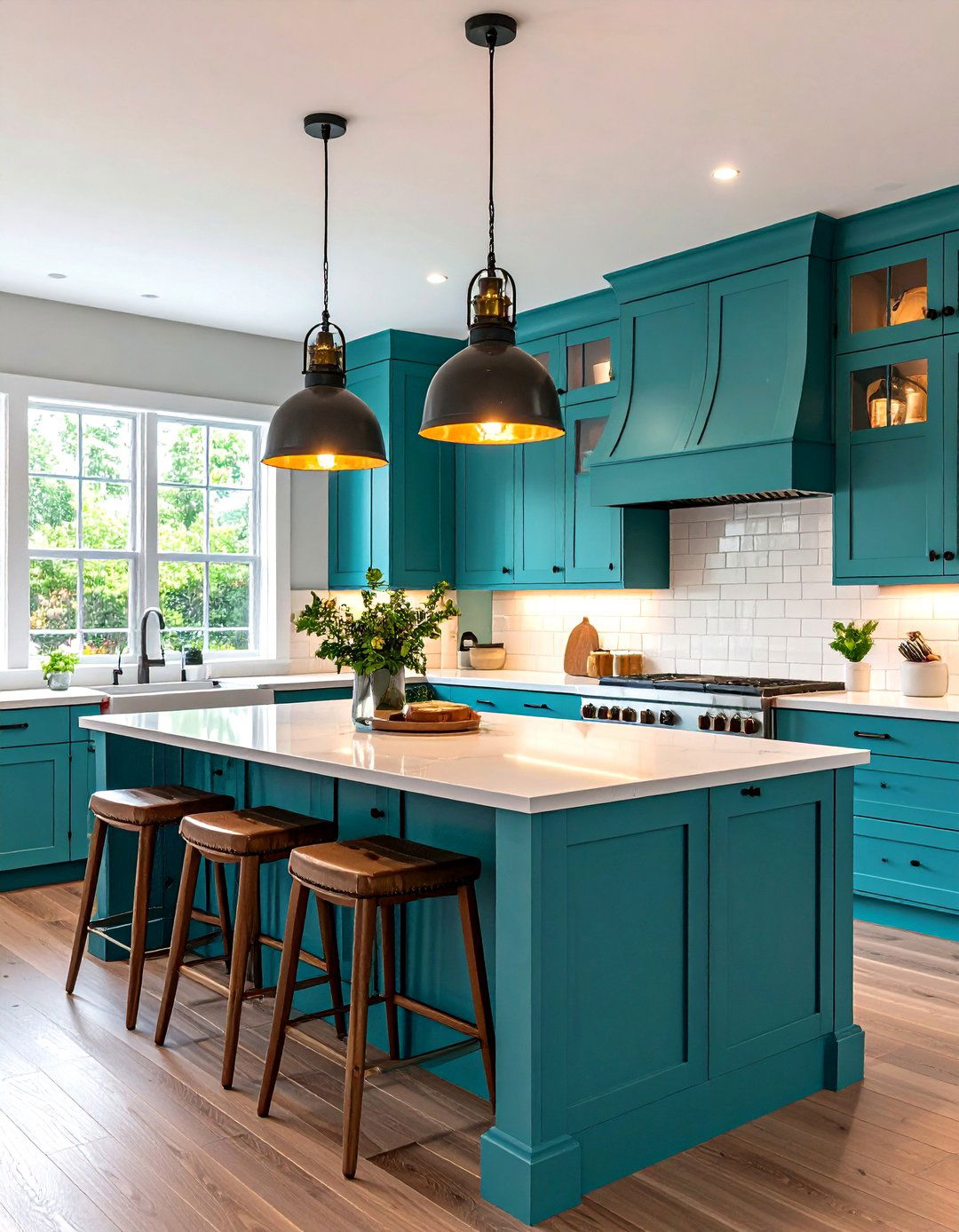
Layer teal with eclectic patterns, global textiles, and bold artwork for a bohemian kitchen full of character. Teal cabinets paired with patterned tile backsplashes—Moroccan or patchwork styles—introduce visual complexity. Incorporate open shelving displaying colorful dishware and potted plants to enhance the boho spirit. Mix in rattan chairs, macramé hangings, and copper pots to create a collected, worldly ambiance that feels both vibrant and personal.
15. Teal Industrial Edge
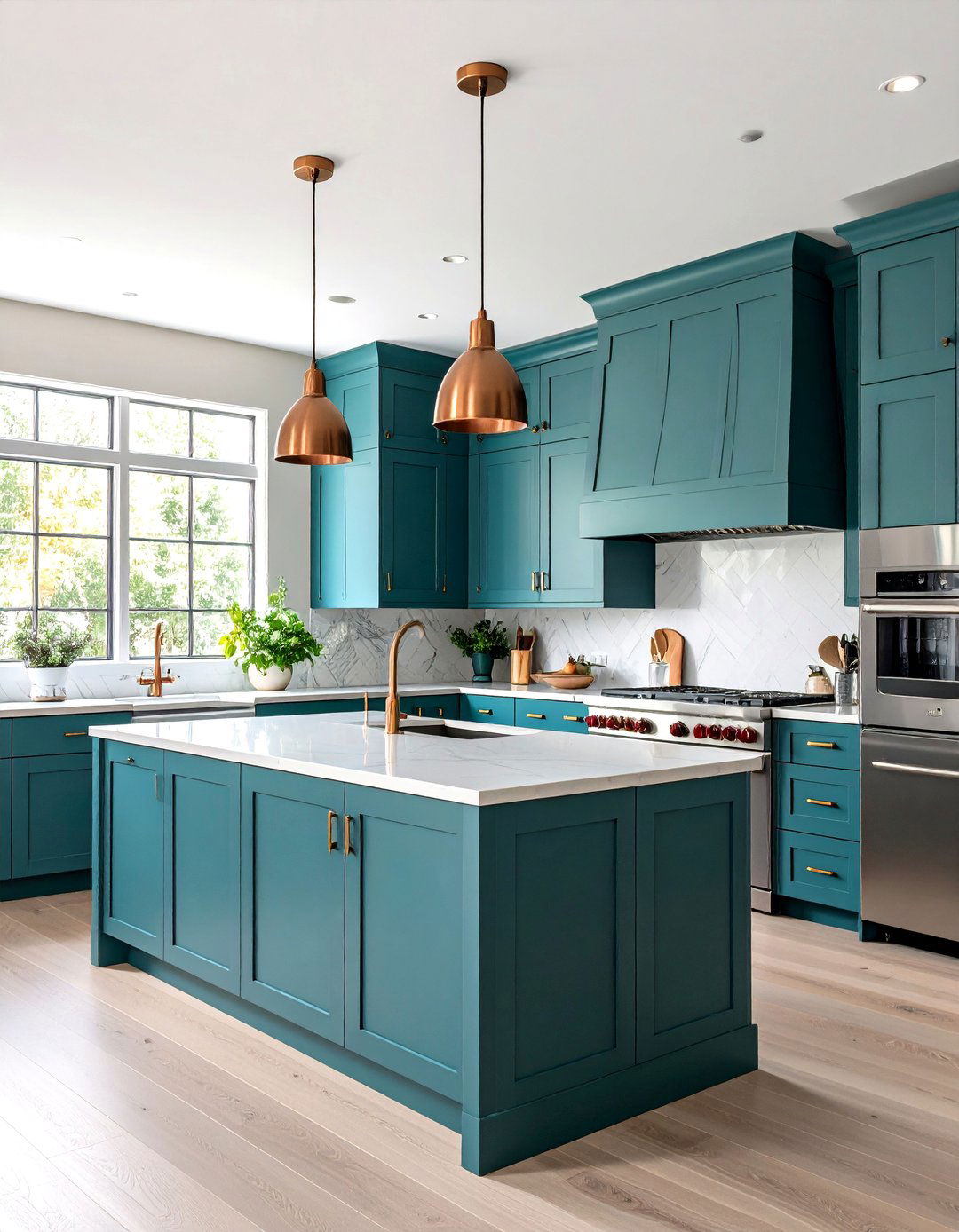
Combine teal with industrial materials—exposed brick, concrete countertops, and black steel fixtures—for an urban, loft-style kitchen. Teal cabinetry softens the rawness of concrete and metal, adding warmth and color. Use open shelving with steel brackets, pendant lights with Edison bulbs, and a stainless-steel range hood to reinforce the industrial vibe. This blend of gritty textures and jewel-tone color results in a kitchen that’s both edgy and inviting.
16. Teal Vintage Touches
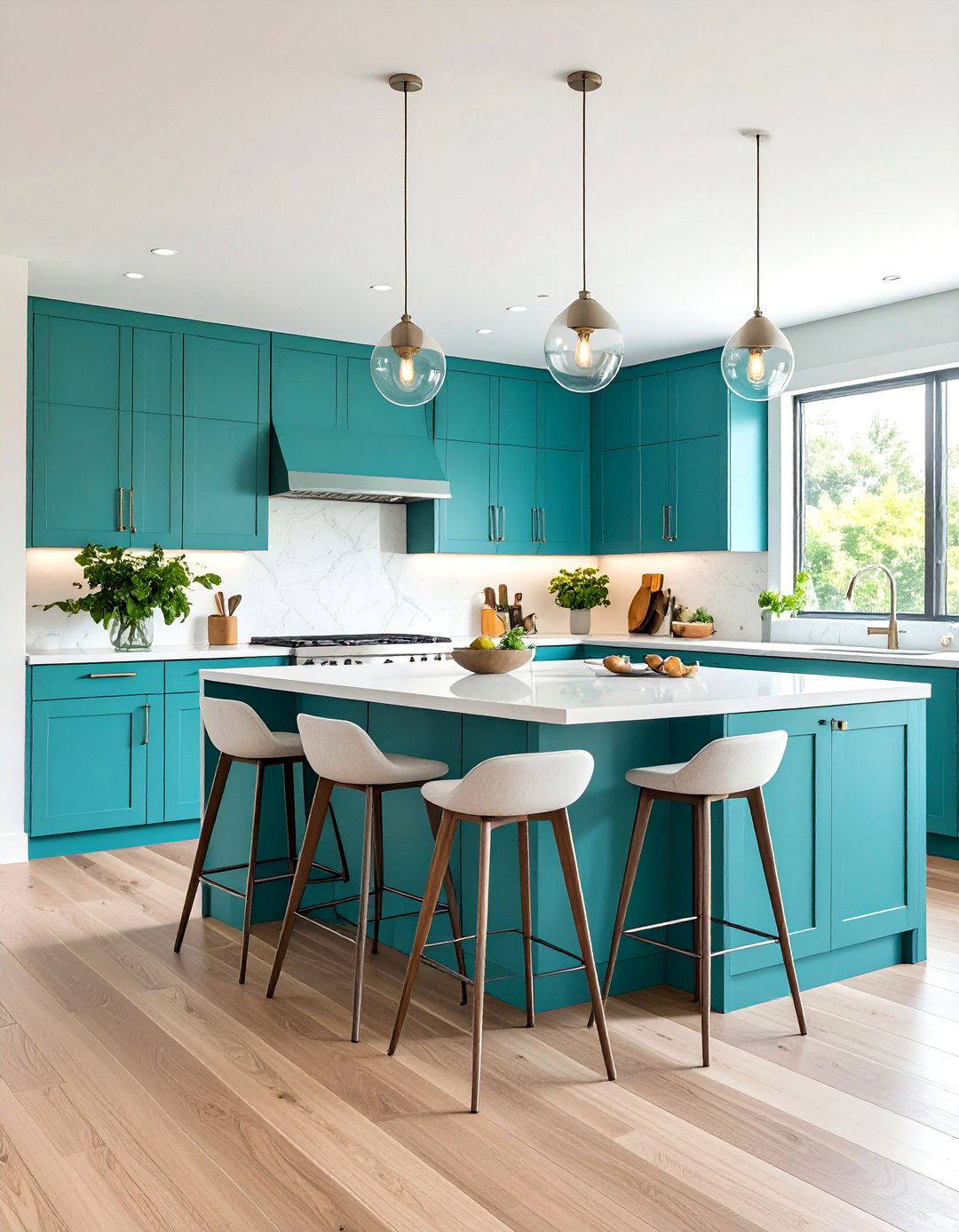
Invoke nostalgia by pairing teal with retro elements—checkerboard floors, vintage appliances, and subway tile. A teal retro fridge or Aga cooker becomes an instant focal point against classic black-and-white tile or beadboard walls. Vintage glass cabinetry pulls, scalloped shelf edges, and pastel-toned accessories complete the look. This style feels charmingly old-fashioned while still benefiting from modern functionality and finishes.
17. Teal with Metallic Accents
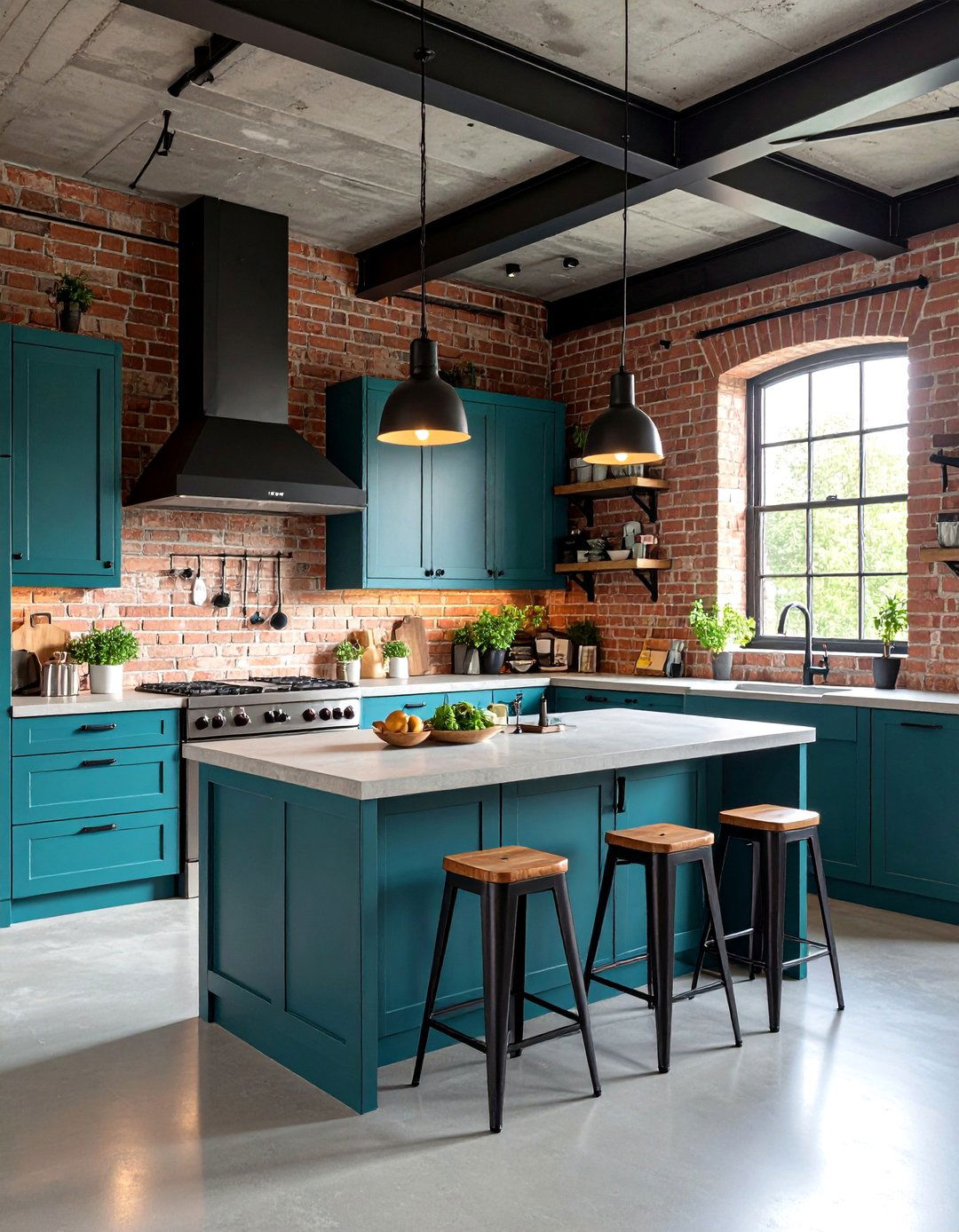
Beyond brass, teal harmonizes with other metals—copper, bronze, and stainless steel. Copper pendant lights and backsplash details add warmth and artisanal flair, while stainless-steel appliances and fixtures reinforce a modern edge. Bronze faucets and cabinet hardware lend a subdued elegance, bridging warm and cool tones. Distribute metallic accents strategically to ensure they complement rather than compete with the teal, creating a balanced, layered look.
18. Teal Lighting Fixtures
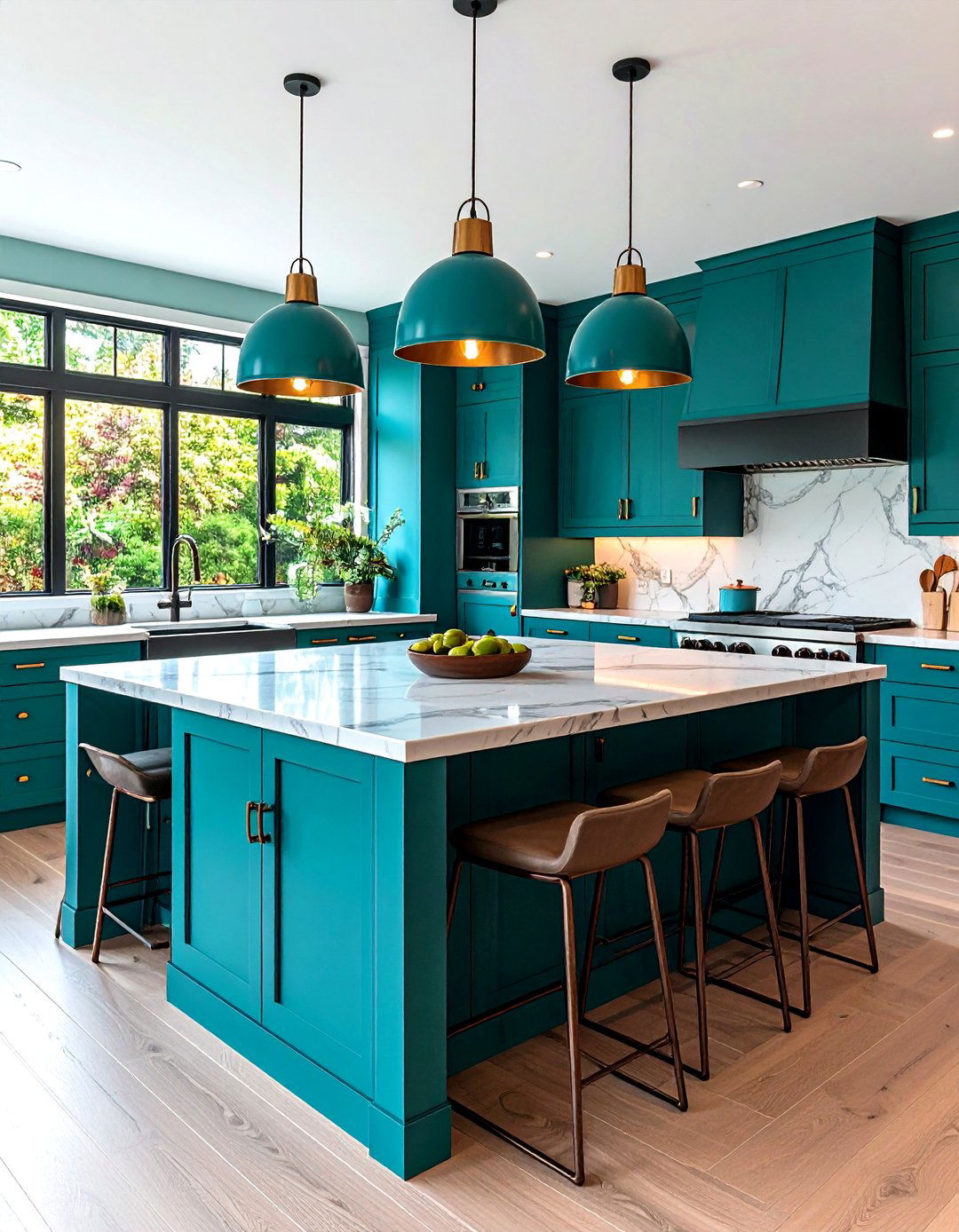
Lighting in teal hues or with teal accents can subtly reinforce a kitchen’s color scheme. Teal glass pendant lights above an island or dining nook cast a soft, colored glow, enhancing ambiance. Alternatively, incorporate teal lamp shades or painted fixture bases to tie in the color without committing to cabinetry. These lighting elements act as jewelry for the kitchen, adding both function and color continuity.
19. Teal Accent Walls
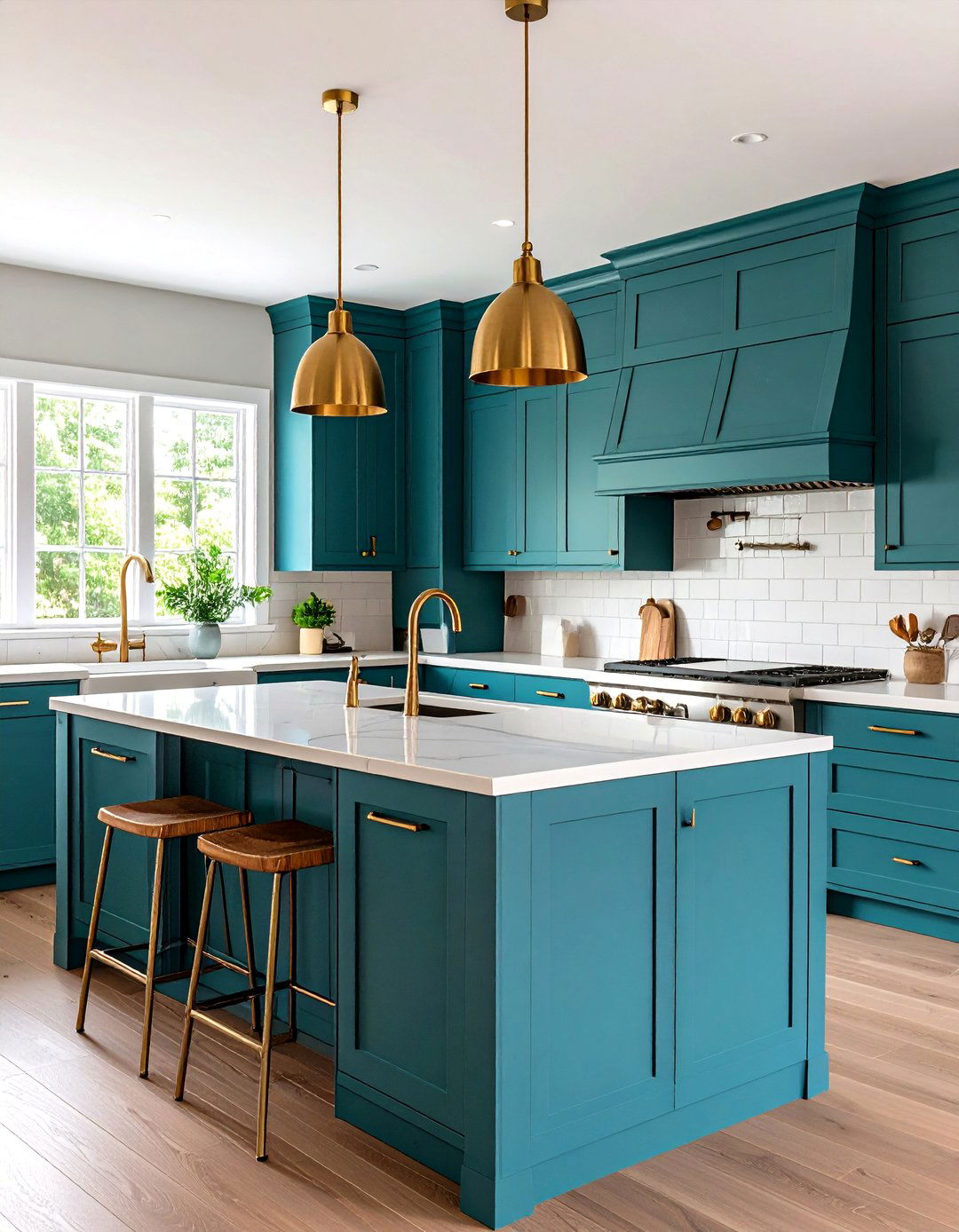
Painting a single wall in teal provides a dramatic backdrop without the permanence of full cabinetry color. Accent walls behind open shelving, dining areas, or breakfast nooks draw the eye and define zones within larger spaces. Complement the teal wall with art, shelving, or floating cabinets to create layered depth. This approach suits renters or those hesitant about extensive renovations, offering a high-impact, low-commitment update.
20. Teal Decorative Accessories
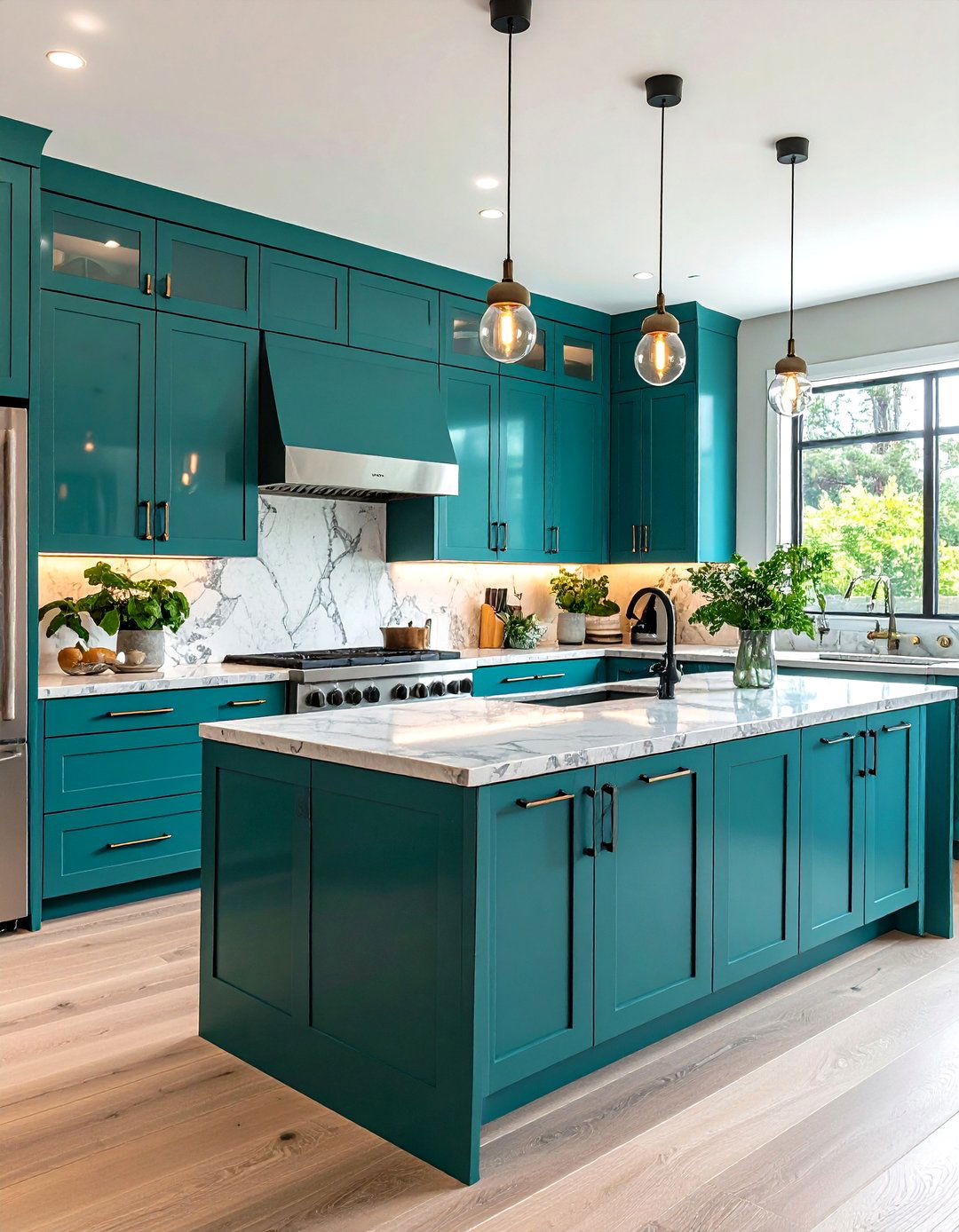
For subtle color infusion, introduce teal through accessories—rug runners, bar stools, dishware, and textiles. Teal kitchen towels, vases, and decorative bowls add pops of color that can be swapped seasonally. This method allows experimentation without major renovation, enabling homeowners to gauge their affinity for teal before committing to larger elements. Accessorizing also ties together existing teal cabinetry or backsplashes, ensuring a cohesive, intentional look.
Conclusion:
Teal offers boundless possibilities for kitchen design, functioning equally well as a bold primary hue or an accent that enlivens neutral schemes. Its versatility spans styles—minimalist, coastal, industrial, bohemian, and vintage—allowing personalization and creativity. Whether through cabinetry, backsplashes, islands, or accessories, incorporating teal infuses kitchens with depth, warmth, and visual intrigue. Thoughtful pairings with metals, woods, and neutrals ensure that teal remains timeless, anchoring designs that feel fresh today and enduring for years to come.



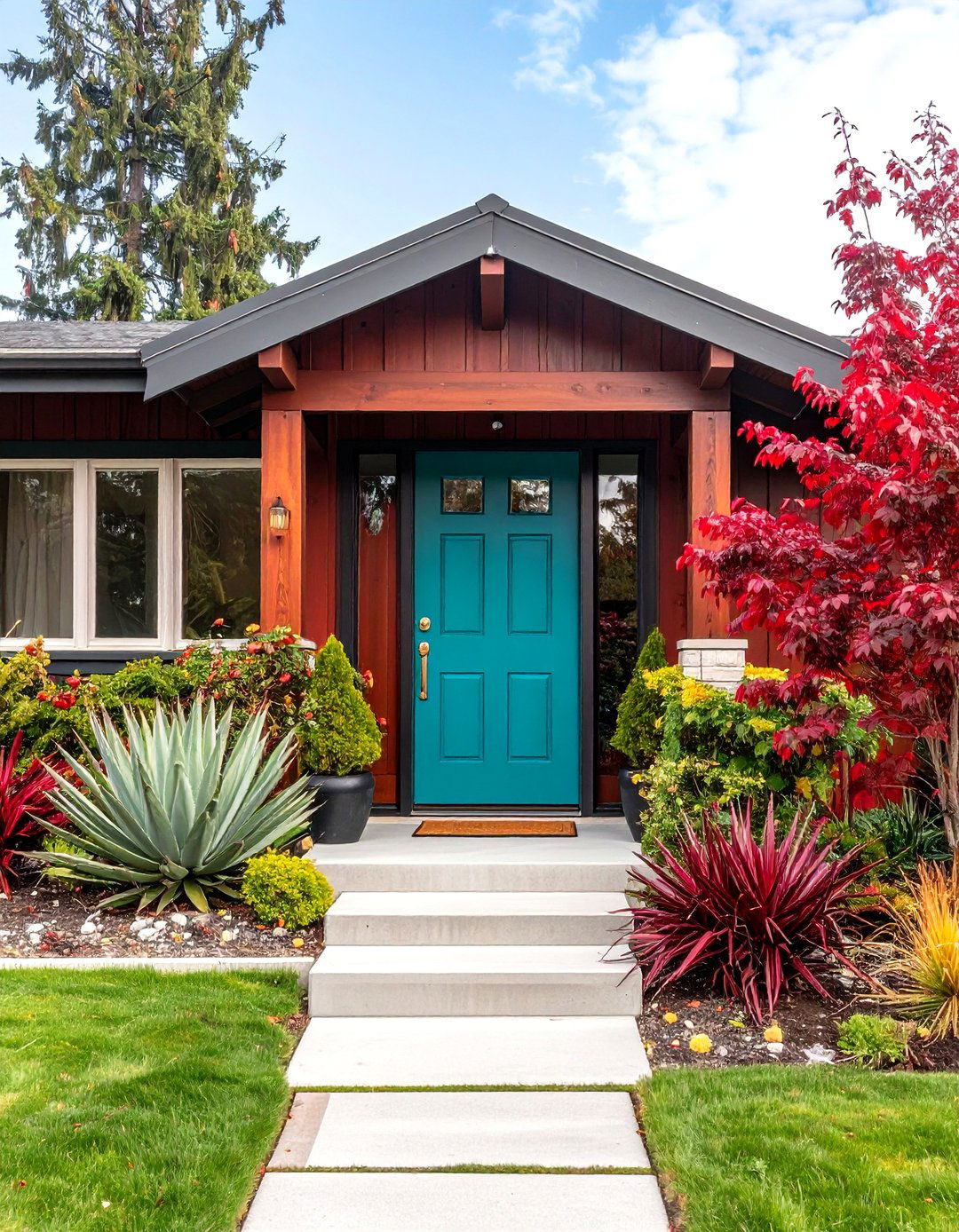
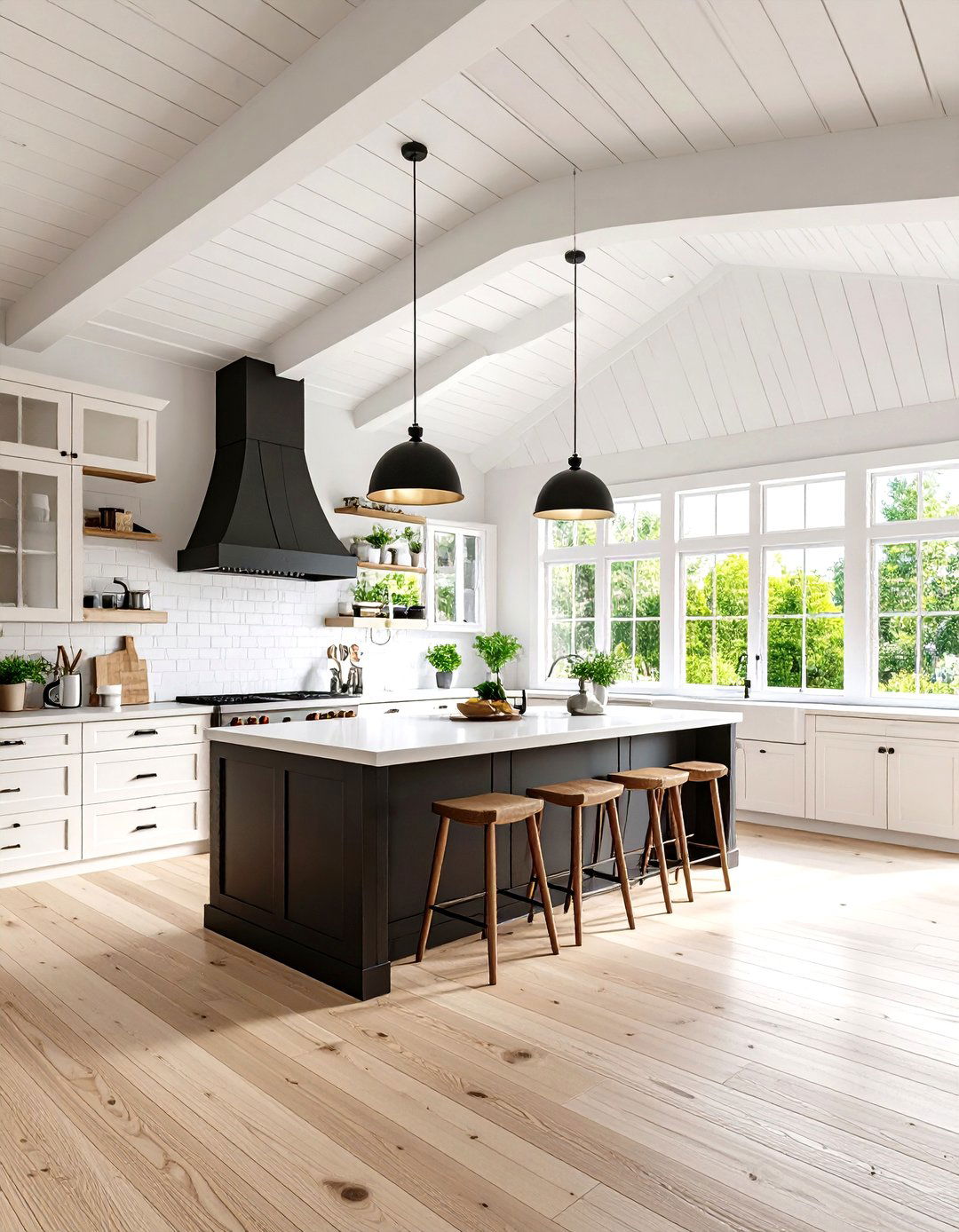
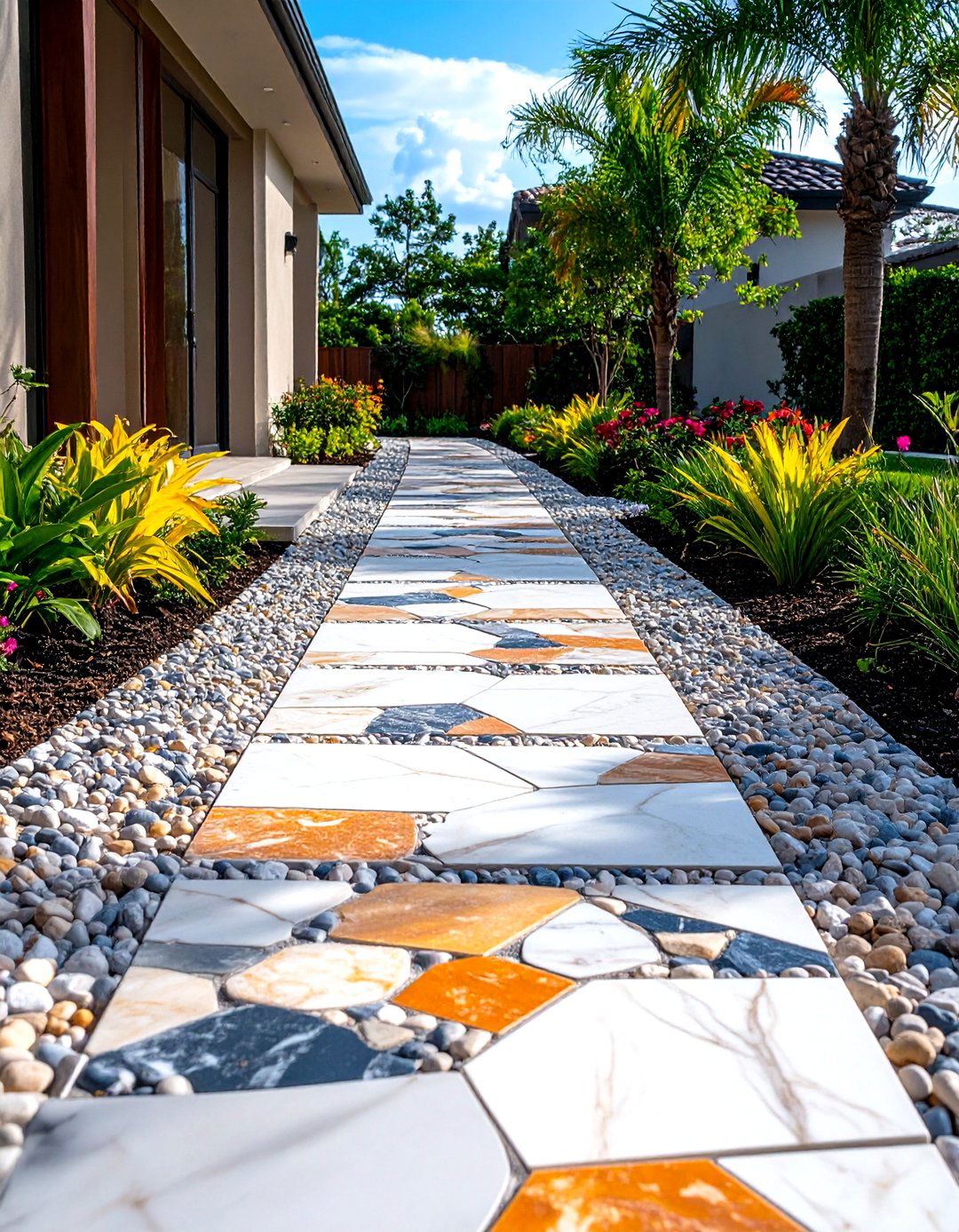

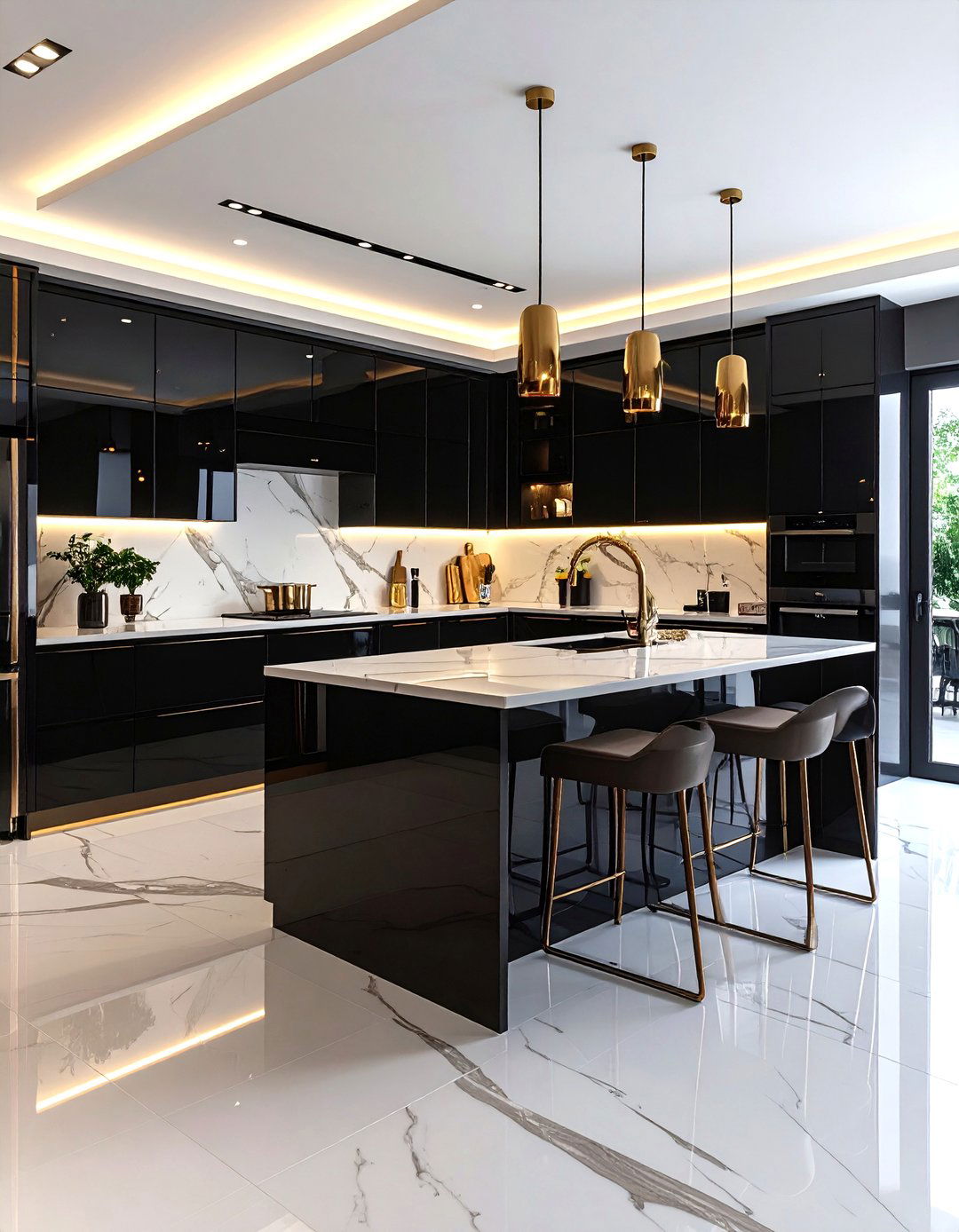
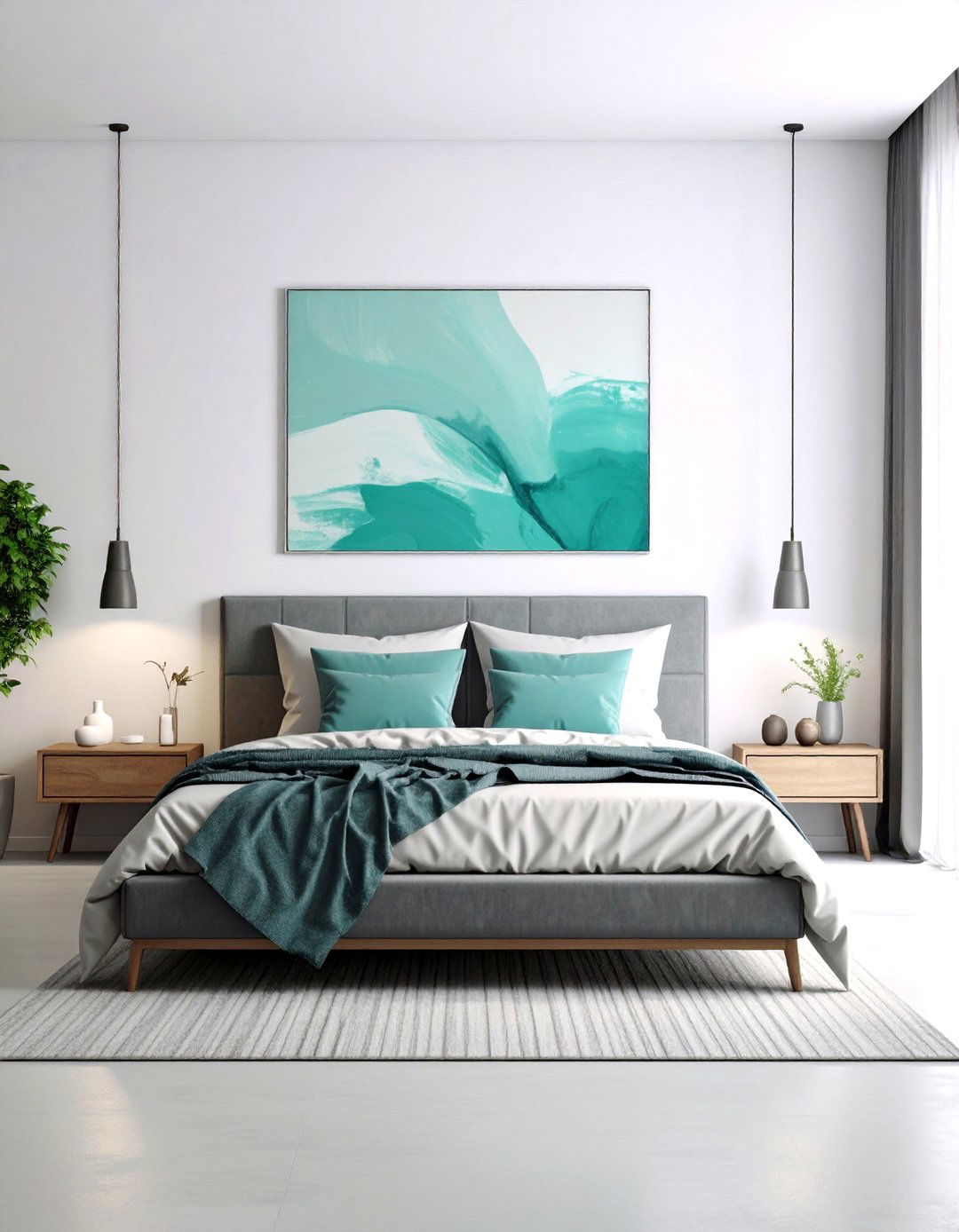
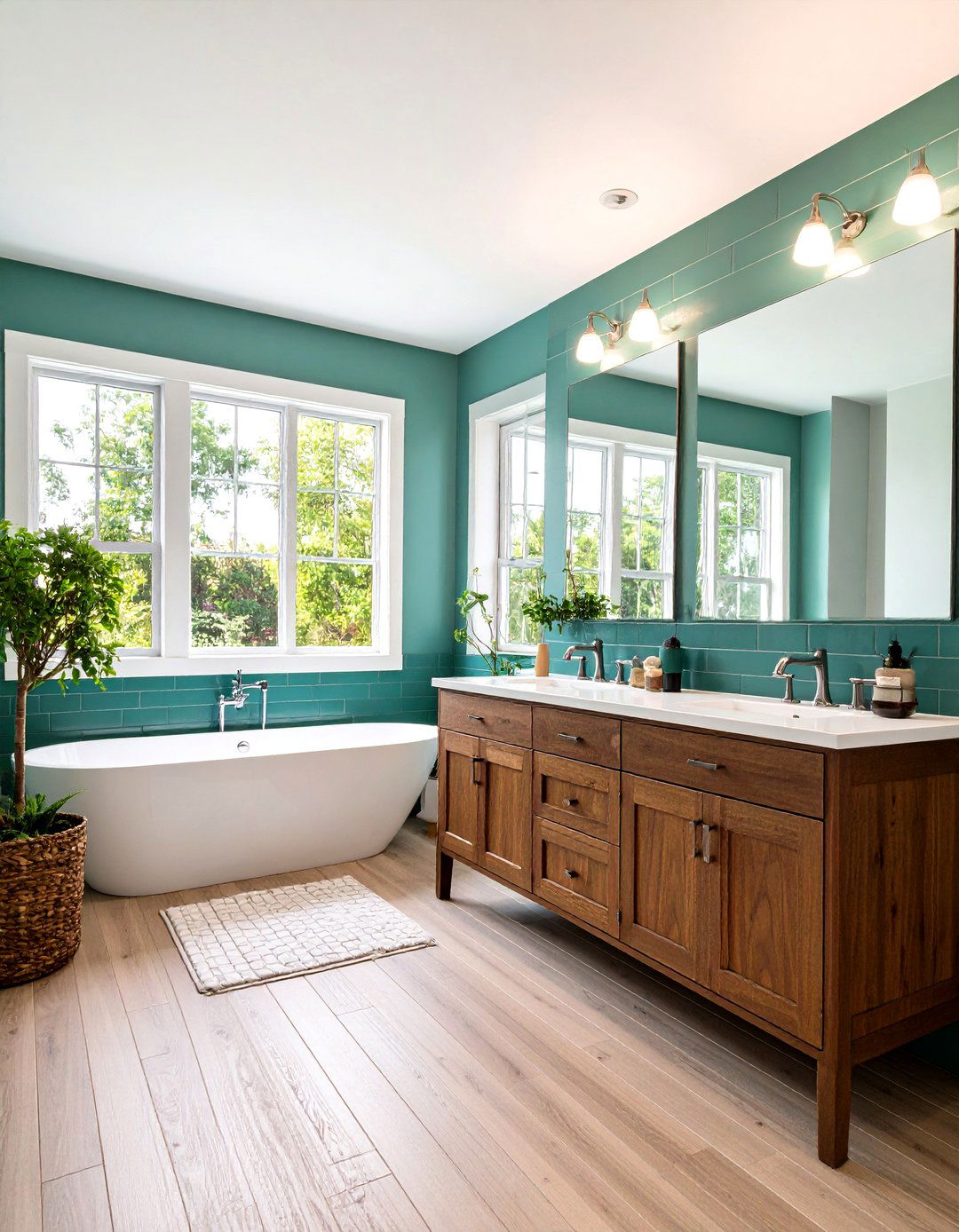
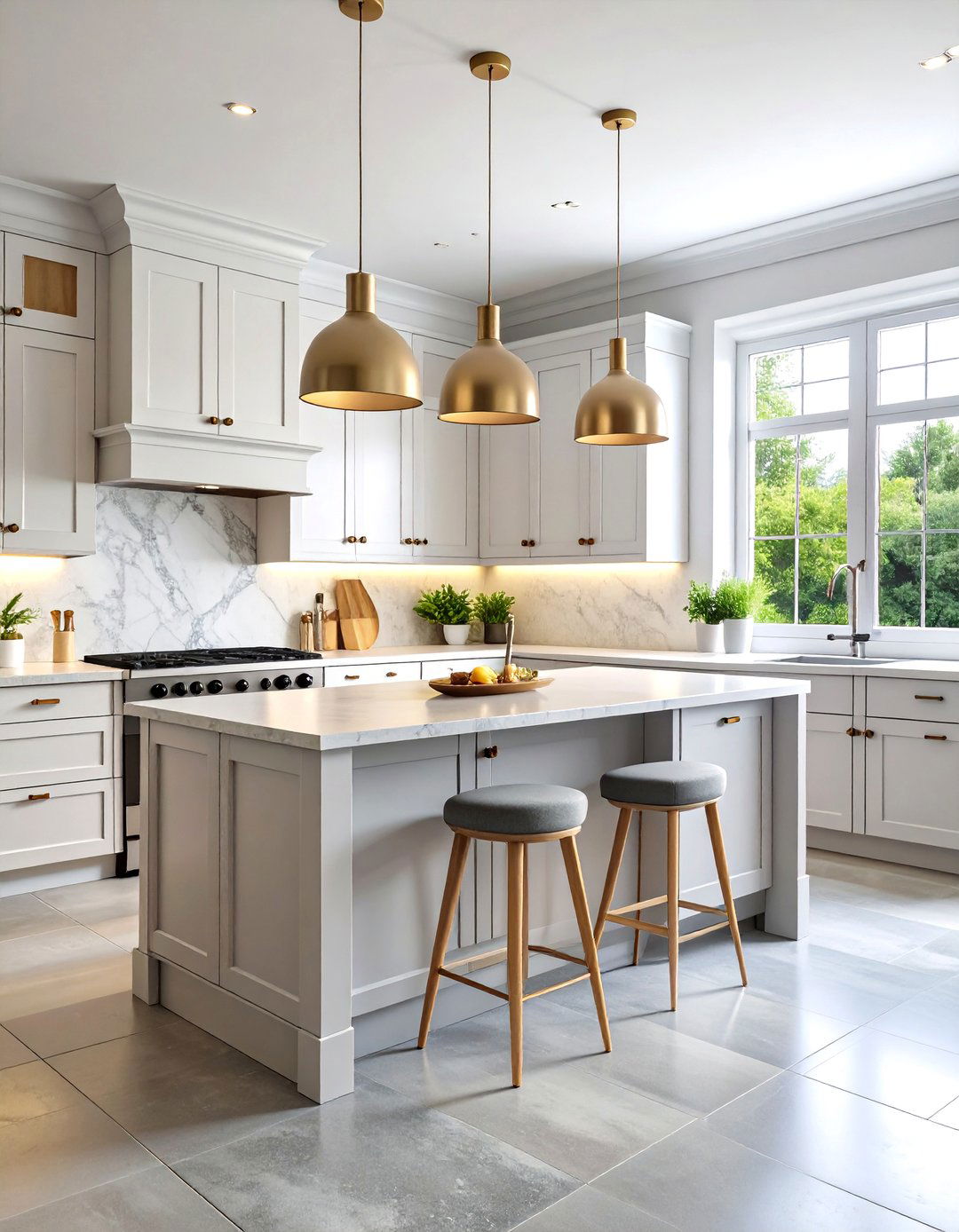


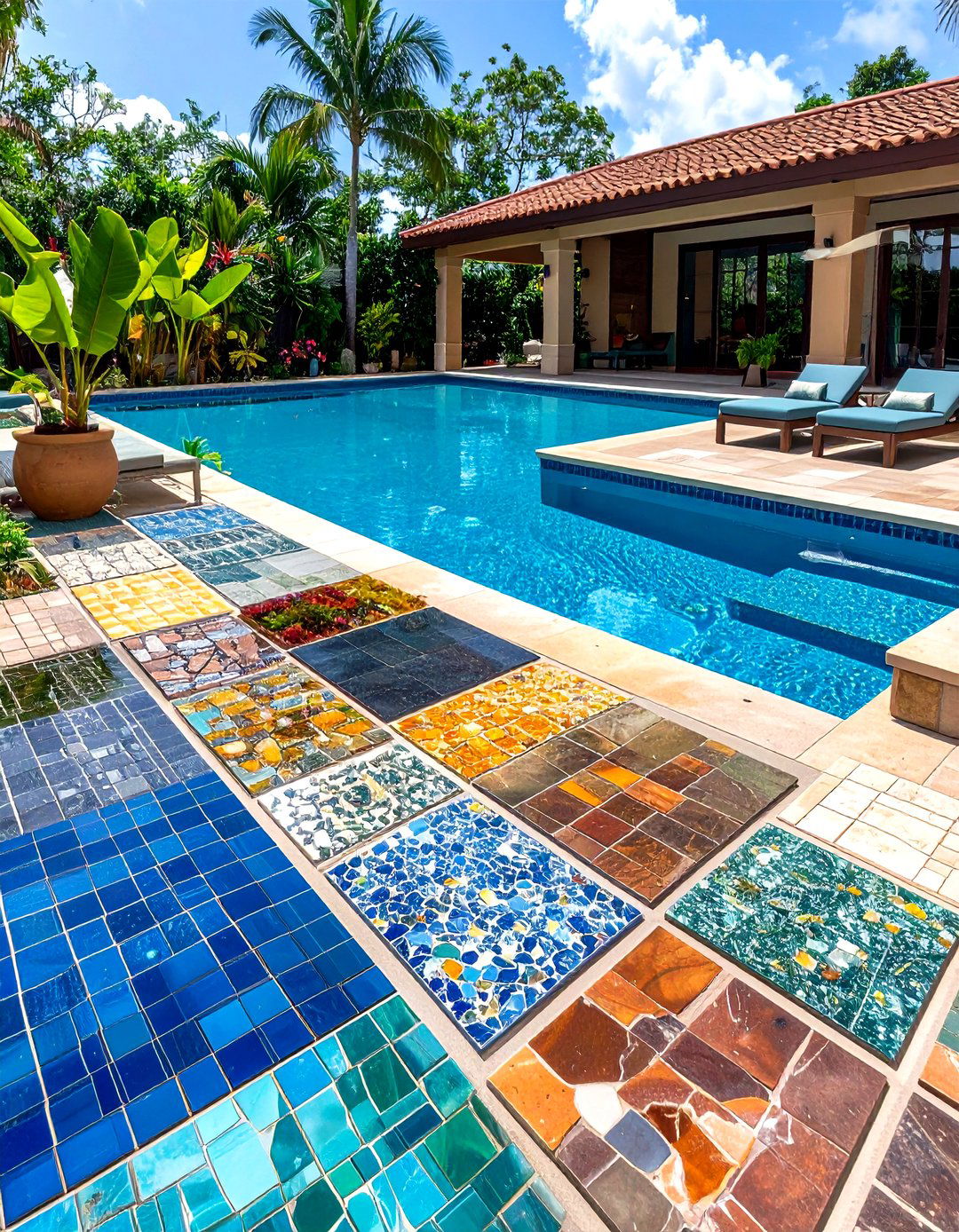
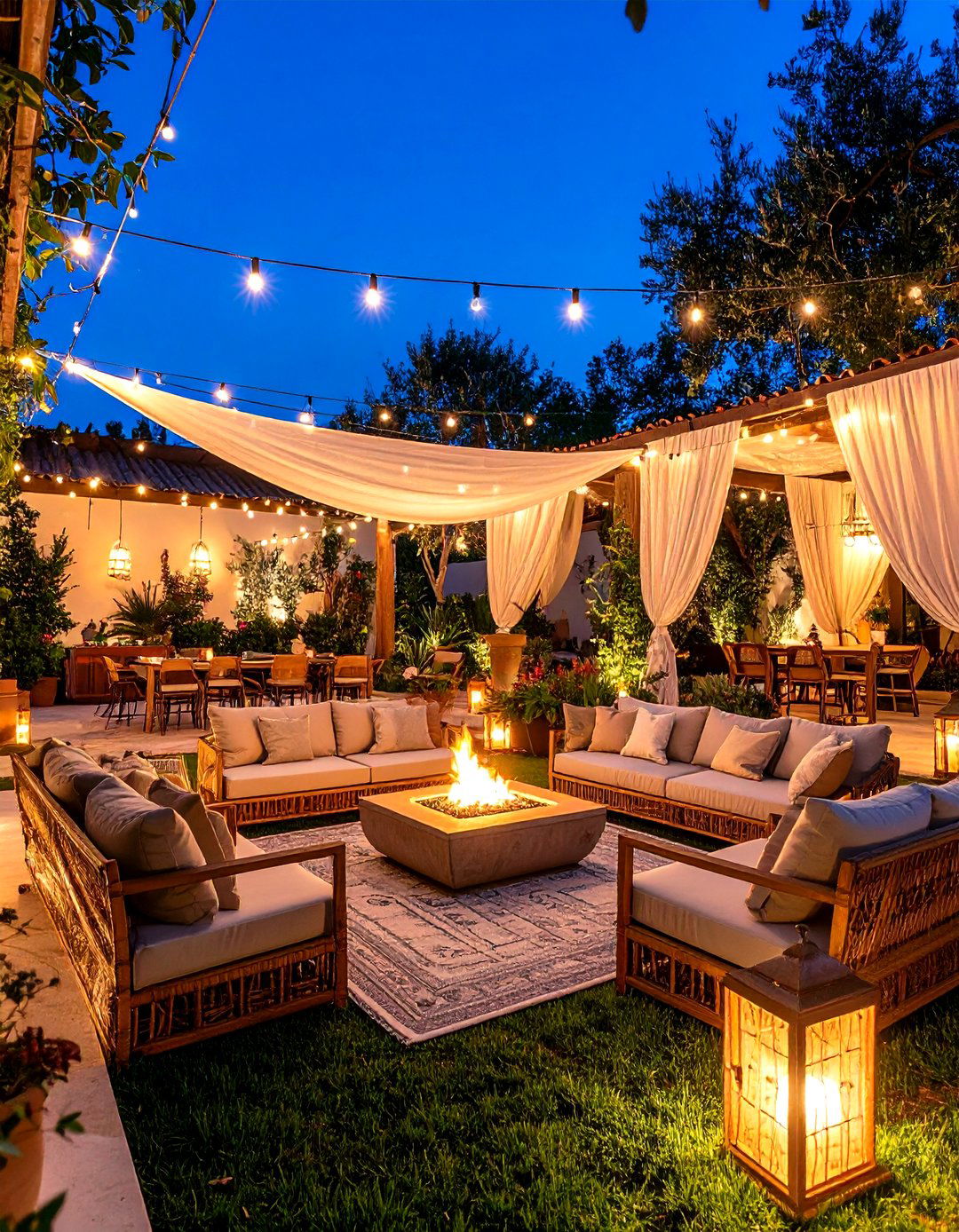
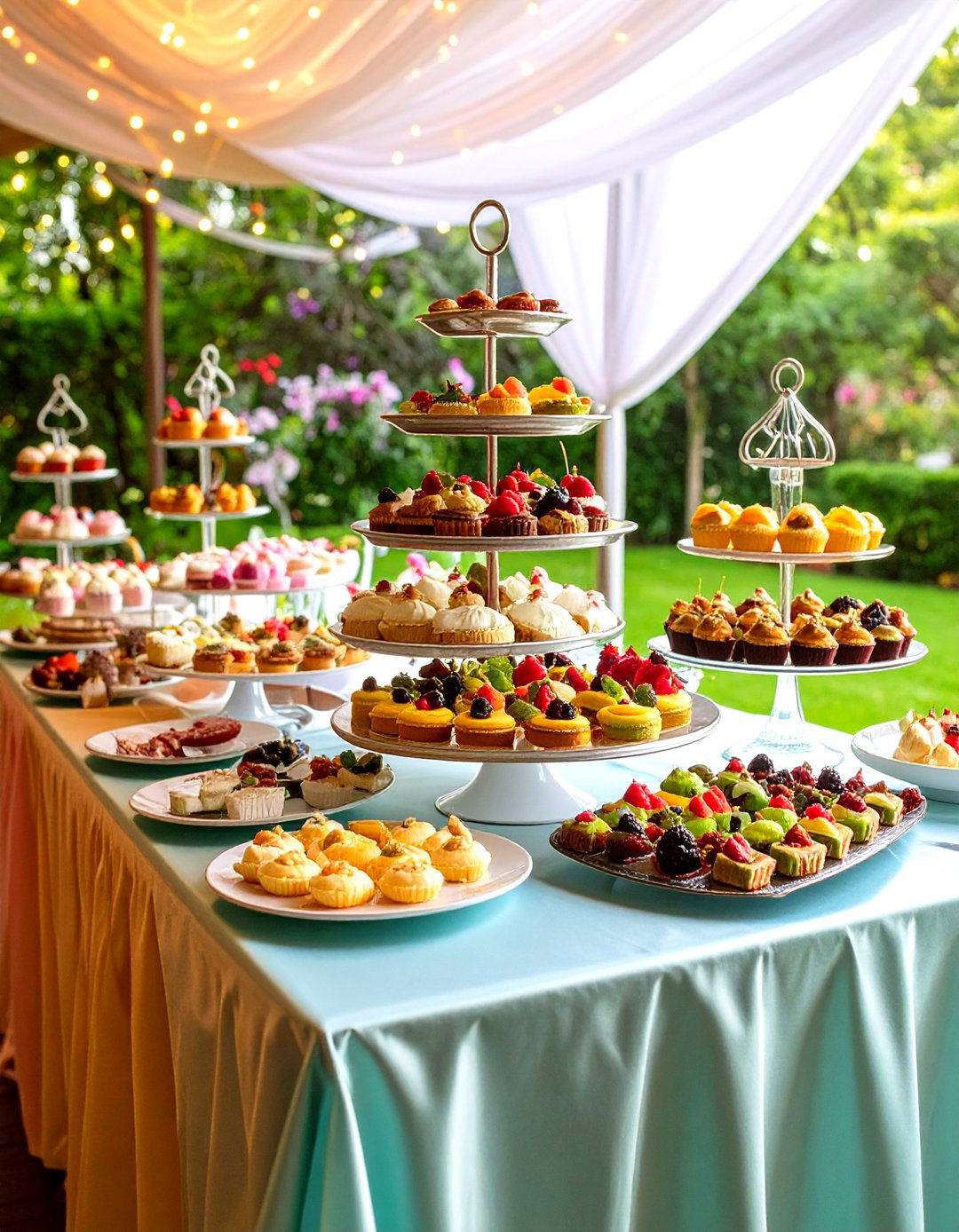
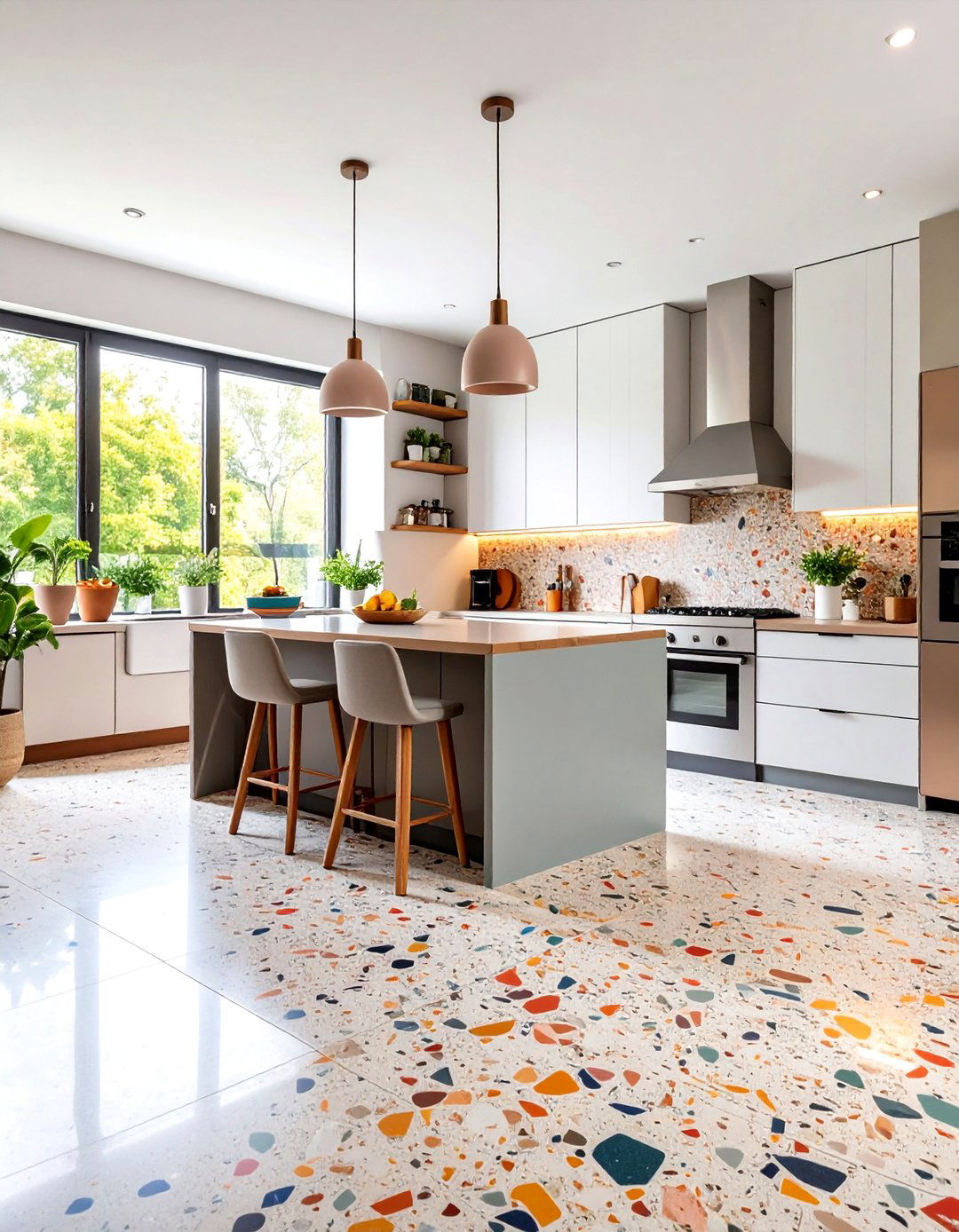
Leave a Reply